

Amboro National Park Tour
Ideally situated in the southern side of Amboro National Park is the spectacular Refugio Los Volcanes. Just two hours’ drive from the city of Santa Cruz this paradise is a place that has to be seen to be believed. The lodge is surrounded by giant sandstone cliffs, waterfalls and tropical jungles of Amboro National Park and it’s truly a world class destination.
Our Amboro National Park tours are a perfect way to see the beaulty of the park with an expert tour guide!
REFUGIO LOS VOLCANES LODGE
Amboro national park.

I deally situated in the southern side of Amboro National Park is the spectacular Refugio Los Volcanes. Just two hours’ drive from the city of Santa Cruz this paradise is a place that has to be seen to be believed. The lodge is surrounded by giant sandstone cliffs, waterfalls and tropical jungles of Amboro National Park and it’s truly a world class destination.
3 DAYS / 2 NIGHTS, 2 DAYS / 1 NIGHT or Full Day
Example itinerary, 3 days / 2 nights, 2 day / 1 night, day 1: santa cruz / refugio los volcanes.
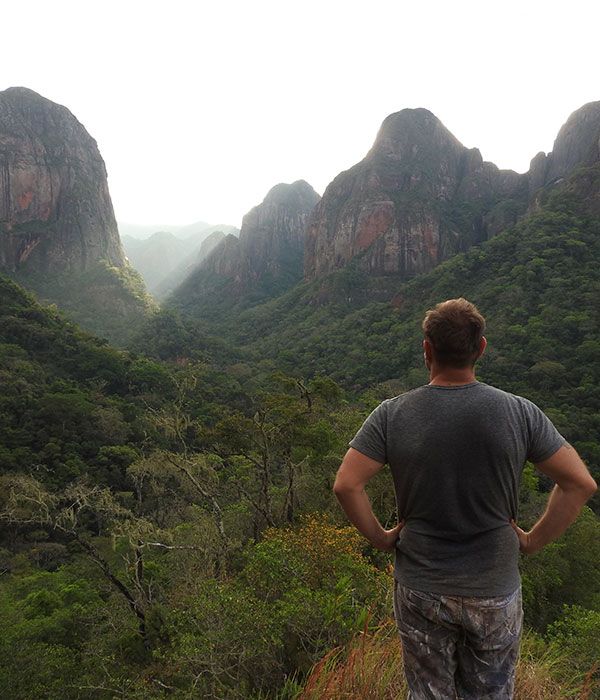
08:30 AM Approx. Hotel pick up and drive towards the lodge, this trip takes around 2 hours, before we stop at the Mirador of Refugio, here we stop for 15 minutes or so to take pictures of the incredible views before we swap vehicles to a small 4WD and drive 20 minutes down the valley to reach the lodge.
Here we will check into the rooms and visit a beautiful waterfall, where we can spend an hour or so swimming and taking photos of the surroundings
12:30 PM Lunch
Rest time to swim in waterfalls.
15:00 PM we will go on a 2 or 3 hour trek on one of the areas many trails, along the way will be learning about the plant life, surroundings, the park and observing birds /wildlife
17:30 PM Return to the lodge
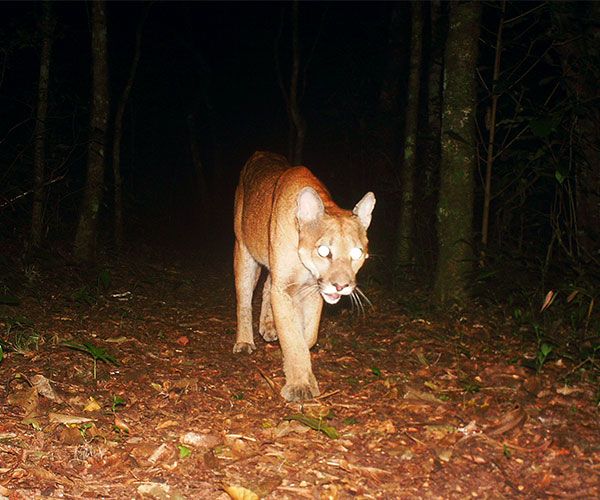
19:00 PM Dinner
Optional Night walk
DAY 2: REFUGIO LOS VOLCANES
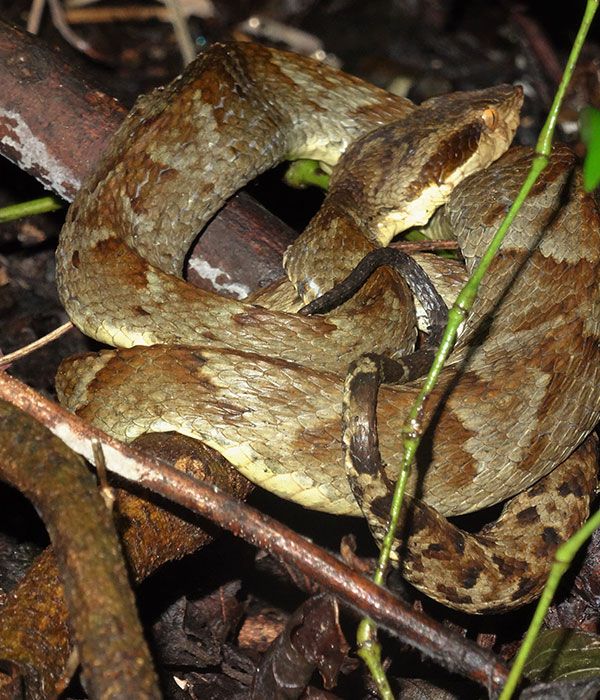
07:00 AM Breakfast
08:00 AM Depart for the trek into the Amboro National Park, this trek can take up to 7 hours and we trek through a range of rivers and the views are incredible, we will visit a few waterfalls along the way, check and set up the camera traps in the area and observe areas for birds and wildlife.
Lunch will either be at the lodge or a picnic at a secluded waterfall.
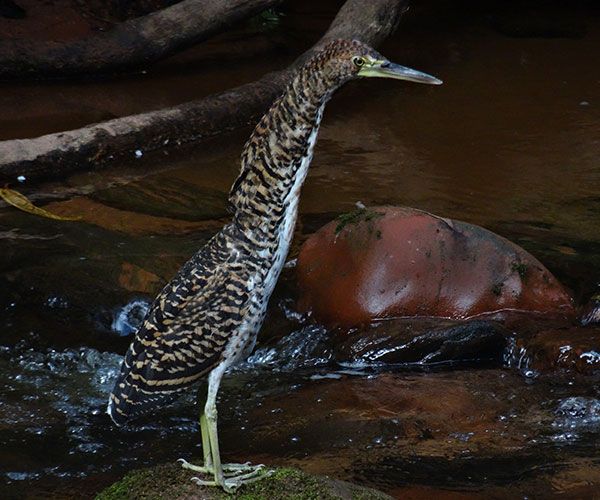
If time permits a small walk in the evening then dinner and optional night walk.
DAY 3: REFUGIO LOS VOLCANES / SANTA CRUZ
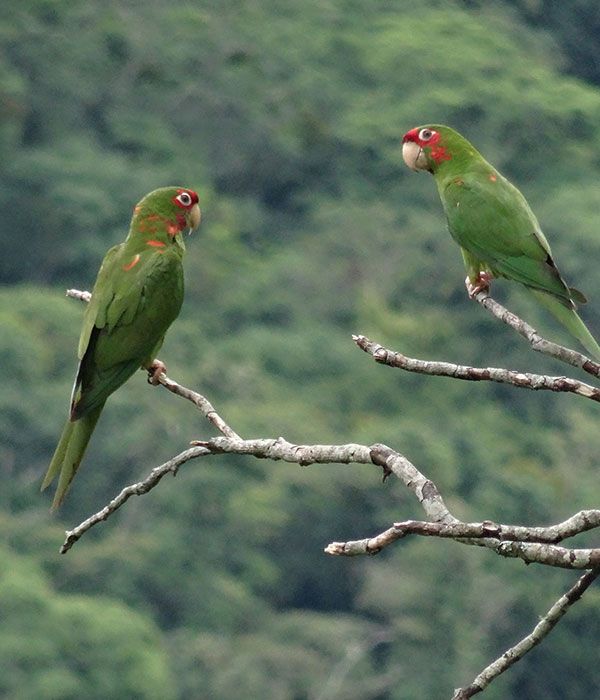
08:00 AM trek into one of the areas trails; here we will be looking for orchids, birds, which include Military Macaws and Condors, plus hopefully get sightings of Monkeys or even larger mammals, which are in the area.
14:30 PM visit the spectacular waterfalls
16:00 PM we check out of the room and depart the lodge; we will meet the main vehicle at the top of the Mirador of Refugio before returning to Santa Cruz.
18:30 PM Drop off in Hotel in Santa Cruz.
End of service.
Please note this is just an example tour plan, this itinerary completely depends on the tourists physical limitations, climate conditions and the tourist themselves, for example if you want to focus the tour on just bird watching this can be arranged.
DAY 2: REFUGIO LOS VOLCANES / SANTA CRUZ
End of service
07:30 AM Approx. Hotel pick up and drive towards the lodge, this trip takes around 2 hours, before we stop at the Mirador of Refugio, here we stop for 15 minutes or so to take pictures of the incredible views before we swap vehicles to a small 4WD and drive 20 minutes down the valley to reach the lodge.
10:30 AM Visit waterfalls
14:00 PM we will go on a 2 hours trek on one of the areas many trails, along the way will be learning about the plant life, surroundings, the park and observing birds /wildlife
17:00 PM Departure to Santa Cruz
19:00 PM Drop off in Hotel
End of sevice.
Please note this is just an example tour plan, this itinerary completely depends on the tourists physical limitations, climate conditions and the tourist themselves, for example if you want to focus the tour on just bird watching this can be arranged

Santa Cruz or Samaipata
Santa Cruz or Samaipata (Optional)
Standard /Private
Accommodation and facilities
Colonial style lodge.
- Spacious lawn and views
- Capacity 12 guests, six double rooms with private bathroom
- Portable water and solar/hydro system
- Modern bathroom and hot showers
- Kitchen/bar
- Hammocks to relax and take in the spectacular views
- 8 Small library
- Clean walking trails with guide to a number of excellent attractions
- International and Vegetarian dishes
See the video tour
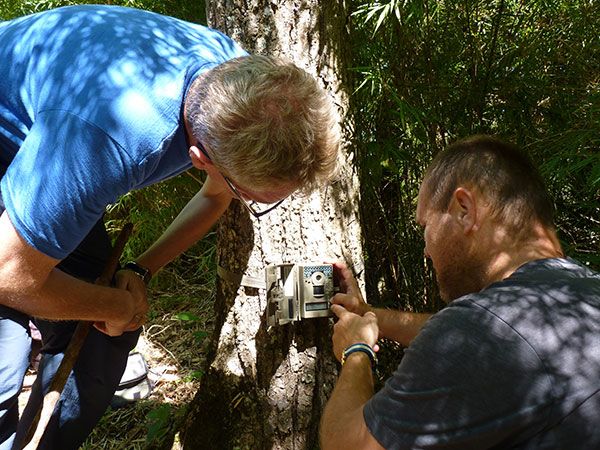
AMBORO NATIONAL PARK AND SAMAIPATA
Explore the most beautiful areas of the Santa Cruz
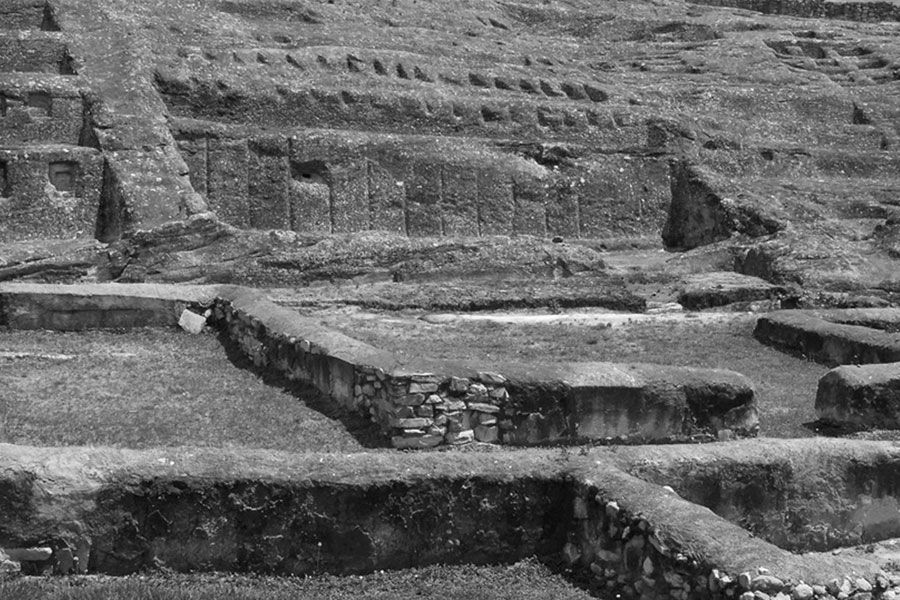
SAMAIPATA TOUR
The delightful bohemian town
Plan your vacation

NICK'S ADVENTURES BOLIVIA AWARDED 2019 CERTIFICATE OF EXCELLENCE FROM TRIP ADVISOR
- Tours by Type
- Tours by Destination
- Tours by Duration
- Package Tours
Nick´s Adventures
- Tripadvisor
- Terms & Conditions
- Barrio Equipetrol, Calle La Plata Este (entre Av San Martin y Canal Isuto), Edificio Nano. Oficina 119.
- (591) 78458046
- (591) 78458045
- (591-3) 3 441820
- [email protected]
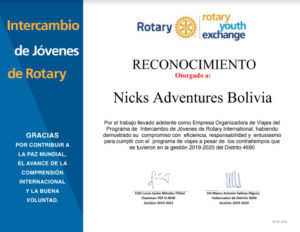
- Tripadvisor
- See ALL TOURS Here
- Tours By Place
- Salar de Uyuni
- Lake Titicaca
- Cochabamba and Santa Cruz
- Amazon Basin
- Tours By Type
- Bolivia Wide
- Most Popular
- Overland Expeditions
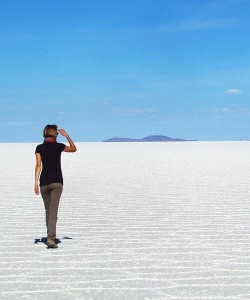
- Recommended:
- San Pedro de Atacama
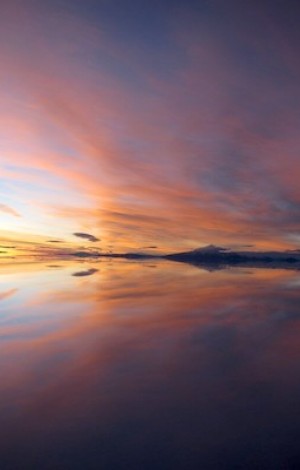
- See All Trips New

- Sajama National Park
- Custom Tours
- SOUTHERN AMBORO NATIONAL PARK (REFUGIO LOS VOLCANES) - 2 DAYS
Southern Amboró National Park (Refugio Los Volcanes) - 2 Days
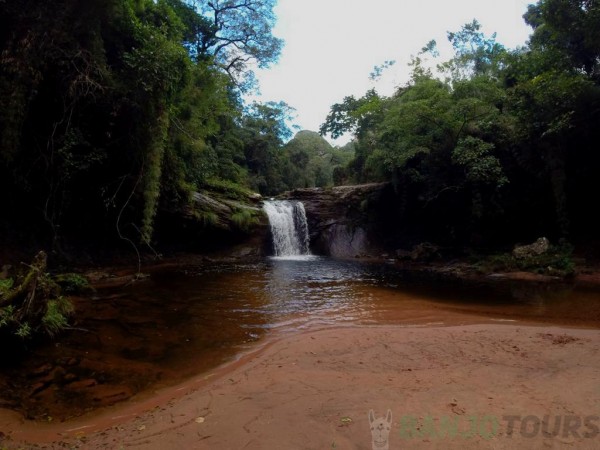
Home to lush rainforests and an astonishing diversity of wildlife, Parque Nacional Amboro has long been a coveted destination in the protection of natural heritage in Bolivia. Experience this gorgeous region on a fun-filled adventure with plenty of hiking trails, pristine waterfalls, birdwatching and relaxing times, taking you from the city of Santa Cruz to Refugio Los Volcanes in the southern part of the park.

This morning, a couple of hours’ drive will take us from Santa Cruz de la Sierra to the southern rim of Amboro National Park, where the imposing ‘volcanoes’ (sandstone rock cliffs) rise majestically from the tropical rainforest. Upon arrival at the mirador (the high gateway overlooking the lodge) you will discover why it is called ‘Refugio Los Volcanes’. A small 4WD vehicle will drive us deep into the clearing where the lodge is located. You will be shown to your room and allowed a short rest. Fresh lunch will be served in the restaurant and the afternoon will be left for you to choose among several hiking trails. You will have the opportunity to learn about the flora, including orchids, bromeliads and plenty more of plant species. Enjoy the breathtaking vistas before returning to the lodge for a pleasant evening with dinner included.
Included: Lunch, dinner
Today, we will have a guided tour of the cloud forest, walking the paths that wind their way through gigantic ferns, ducking underneath the lichen and moss that hangs from the giant trees of Parque Nacional Amboro. The jungle floor is often littered with blossoms that fall from the high canopy providing a myriad of colors amidst the endless green. Wildlife is elusive, but if you’re lucky, you may get to see several species of unique birds (over 200 species have been registered) and mammals. The rest of the day is left free to enjoy one or more of the optional activities available in the area. One of the most popular activities is to take refreshing baths in natural pools by the river or relax on a hammock before embarking on the drive back to the city of Santa Cruz. Arrive back in town in the evening being dropped off right at your accommodation.
Included: Breakfast, lunch
IMPORTANT NOTES
- Wildlife watching is not guaranteed. Being located in an accessible part of the park, viewing large mammals is rare
- About 80% of the drive is on a paved road/highway. The rest is on a winding and bumpy dirt track for which an appropriate vehicle will be provided
- You may choose to not request a specialized, bilingual guide, in which case a local, non-bilingual guide will show you through the trails and provide limited information. We recommend opting for a specialized guide that will accompany you from the city of Santa Cruz (price is higher) though it is not mandatory
WHAT'S INCLUDED
- Private transportation from Santa Cruz to Santa Cruz (return)
- 1 night(s) accommodation in private, twin room
- 2 lunches, 1 dinner, 1 breakfast
- Bilingual (English/Spanish) speaking guide
- All admission fees
WHAT'S NOT INCLUDED
- Alcoholic and soft drinks
- Optional tips (highly appreciated)

- Ask a Question
- Related Tours
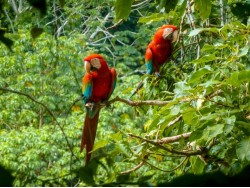
Write a review
- We suggest you also
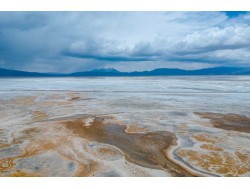
Amboro National Park Overnight Tour from Santa Cruz

- See Bolivia’s diverse wildlife and plants at Amboro National Park
- Personalized itinerary is designed for your private group
- Options include hiking, swimming, bird-watching, and photography
- Convenient pickup and drop-off at Santa Cruz hotels
- Overnight lodge accommodation (double or single beds with private bathroom)
- National park fees
- Bottled water
- Meals as per itinerary (Breakfast, Lunch, Dinner)
- Professional guide
- Hotel pickup and drop-off
- Transport by private vehicle
- Pictures from camera trap study of the region
- Alcoholic drinks (available to purchase)
- Airport pick ups/ Pick up outside the 6th ring have an additional cost of USD 40 dollars
- Airport pick ups / Pick up outside the 6th ring of Santa Cruz de la Sierra City have an additional cost of USD 40 dollars for the vehicle
- Not wheelchair accessible
- Infant seats available
- Vegetarian option is available, please advise at time of booking if required
- Travelers must have a valid travel insurance policy
- A current valid passport is required on the day of travel
- Long pants and protective clothing must be worn during treks,
- It is recommend that you bring swimwear, jacket, insect repellent, sunscreen, flashlight, suitable walking shoes, camera, charger and small backpack
- Not recommended for travelers whom are affected by severe altitude issues
- A minimum of 2 people per booking is required
- A maximum of 15 people per booking
- Travelers under 2 years old are free
- Travelers should have a moderate physical fitness level
- This tour/activity will have a maximum of 15 travelers
- If you cancel at least 7 days in advance of the scheduled departure, there is no cancellation fee.
- If you cancel between 3 and 6 day(s) in advance of the scheduled departure, there is a 50 percent cancellation fee.
- If you cancel within 2 days of the scheduled departure, there is a 100 percent cancellation fee.
Similar experiences

- mwest15170 0 contributions 5.0 of 5 bubbles Bucket List Tour I had always wanted to go to Bolivia and I had a very compressed time to do the visit with my dad. Nick and his team listened to what my "musts" were and made every single one of them happen. All of our guides spoke English and Nick and his team were really easy to work with--answering so many of my questions! Now that we know jaguars are in Bolivia we just may need to come back, but we definitely enjoyed our time while we were in Bolivia and it's thanks to Nick. Read more Written April 6, 2024
- Karin_a_wolls 0 contributions 5.0 of 5 bubbles Bolivian off the beaten track tours. Excellent organization to help you select one of all the tours they offer. They respond immediately and answer all your questions. Read more Written April 2, 2024
- Jrt95 0 contributions 5.0 of 5 bubbles Wildlife spotting in the Gran Chiquitania and Parc Nacional Bolivia A very well organised trip that allowed us to spot many wildlife species in Bolivia across two different biospheres - the Gran Chiquitania and the Amazon Basin. Hugo (guide), Cesar (driver) and Natalie (cook) was the team for our 3 days in the Gran Chiquitania. The food was delicious. And Hugo and Cesar really did go all out for the sighting of the jaguar. Am very impressed by Cesar's eyesight and how he could spot and identify wildlife from afar. Hugo also impressed with his knowledge of the animal species. For our 3 days in Parc Nacional Madidi, Nelson was our guide. He also ensured that we had a fulfilling experience by bringing us to the areas where we are more likely to spot different wildlife species. The highlight for this part of the tripwould have been piranha fishing in the lake. Overall, a well organised customised trip where we learnt a lot about the biodiversity of Bolivia Read more Written December 26, 2023
- schlegal1 0 contributions 5.0 of 5 bubbles Excellent experience on the Jaguarland tour With the right expectations, this is a terrific trip. We did two nights to Jaguarland to experience Bolivian wildlife. We experienced tons of it (no jaguars, unfortunately but Mother Nature is her own boss). We were really happy with Nick's: 1. Quick replies to email inquiries and planning emails in advance of the trip. 2. Complete professionals. They were on time for our pick-up, they had a good quality vehicle with working A/C, the guide's English was completely fluent, the cook carefully followed our food protocols (accommodating some unusual allergies and a vegetarian), the driver was attentive to the road and drove safely. 3. The privacy of the property where you view wildlife is incredible--we had all the wildlife to ourselves. 4. Shared the amazing wildlife photos that the guide took with us since our camera was not nearly as nice as his. 5. The food was amazing and abundant. We felt so well cared for by our cook. She made amazing meals for us. I am a vegetarian who doesn't like eggs--about every time I take a trip and explain this, someone still tries to feed me eggs but never ONCE did that happen this trip. They were also very careful about my spouse's unusual allegies. All the food was cooked fresh and the cook cleaned up the kitchen and used hygienic practices to keep things sanitary. 6. Our guide was both passionate about wildlife and knowledgeable about it. He was attentive to our needs and comfort and kept us informed about the schedule and plans. His English was as good as if it were his primary language. We saw all the species of monkeys in the area, a variety of macaws, capybaras, Jabiru storks, rheas, a jagarundi(!), foxes, coati, all three types of deer (swamp, red brocket, gray brocket), peccaries, sloth, agouti, cayman, burrowing owls, tons more kinds of birds, a snake of some sort (common--gray with a yellow belly) and some huge toads. Manage your expectations: 1. You are camping. It's hot in the tents on a mattress and the facilities are basic (there is a flush toilet and a shower). 2. Nature doesn't have a schedule--you see what you see, there's no baiting to coax out the animals and no guarantees of any sightings. 3. Mosquitos. Plan to be completely covered and use a spray. Completely covered we still got bites on our hands and faces. There are times when it feels like there is a cloud of mosquitos in the vehicle with you (certain times each morning and evening). 4. No cell service or wifi (mostly--my spouse was able to go to the working encampment and get a enough signal to work a bit). 5. This is not like an African safari game drive--while you will see a lot, the animals don't lounge around and they don't let you get very close. If you want photos, your cell phone won't cut it. 6. You spend a lot of time driving and that is really the only activity. It's too hot to walk around at midday--if you can manage to take a nap in the heat, that's about all you can do. (The property would be greatly enhanced if they added some shaded outdoor areas for hammocks/chairs to relax during this hot time of day). The main complaints I see people making is about the cost. If you read the above, you can decide if it's worth it to you. It is very expensive for Bolivia, yes. For us, it was worth it completely. A unique, private experience with a professional company. Read more Written December 26, 2023
- charleslG1500CD 0 contributions 5.0 of 5 bubbles Incredibly passionate I went with Nick's Adventures on a 3Days/2nights trip to KAA-IYA (the park is highly recommended, I've written a seperate review). Their communication is fast, friendly and clear, every member of their team was incredibly nice and professional and the level of comfort they were able to provide at such a remote place was far above my expectations but what makes travelling with them really special is their love and passion for what they do. I could feel that they were as excited about the trip as I was and combined with their experience and know-how turned this into the greatest wildlife experience I've ever had. Read more Written December 22, 2023
- Global23351444834 0 contributions 5.0 of 5 bubbles Above and beyond, conservatorship, great tours from an amazing human being... Nick and company are perhaps the best way to experience the Amazon and its amazing wildlife. I have lived in Bolivia for over 10 years and have sent many clients to Nick's Adventures Bolivia and have never heard a complaint. Nick's passion for wildlife goes beyond his business. Nick has passionately worked on conservation projects in Bolivia for many years and has raised awareness of the threats facing the Bolivian Amazon among his clients and locals alike. If you are in Santa Cruz, give Nick a call, and head out to the jungle for an adventure. Read more Written December 18, 2023
- 46junt 0 contributions 5.0 of 5 bubbles Central Bolivia Birding Trip We were on a 12-day birding trip with Nick's Adventure Bolivia and it was absolutely amazing. Nick worked with us patiently to create a customized birding route to fit our needs and budget. Our guide, Saul Arias, was an outstanding expert bird guide. He was able to identify many hard-to-see/identify species by ear and sight. We saw nearly 300 species in 12 days, 140 of them being new birds to us. We cannot wait to be back in Bolivia with Nick!!! Thank you! Jun & Noel Brooklyn, U.S.A. Read more Written December 10, 2023
- LIR8 0 contributions 5.0 of 5 bubbles Touring Bolivia Nick's Adventure planned a wonderful trip for my friend and myself. We chose Nick mainly for the jaguarland experience. They ended up planning our entire Bolivia trip. We toured Santa Cruz, La Paz, Trinidad, and Uyini. They organized different tour companies for us in each place we visited. They followed through on all of our flights and were very attentive to our needs. The only tour company we used that we did not really like was in Trinidad. We were only there for one day, and that was mainly to go on the Amazon River to see the pink dolphins. We did see the dolphins with our eyes, but very difficult to photograph as they only surfaced for a few seconds at a time. If going to Uyini, realize that it is at the top of the Andes mountains, (very high altitude.) I got really sick with a rapid heart beat for 36 hours, and that was with taking altitude pills. We wanted to go to a lower altitude, but the flights to Uyini are very limited. I did survive, but it was very scary. Read more Written November 28, 2023
- sherischrdr 0 contributions 5.0 of 5 bubbles Excellent Tour Operator in Bolivia Nick's is the ONLY tour agency I would consider touring Bolivia with. Communications were prompt and helpful. Arrangements were thorough, well thought out and completed with everything as promised. But most importantly, if things go wrong, Nick's agency is the one you want to cover your back. When EcoJet cancelled our internal flights, TWICE, Nick went to bat for us. Through his knowledge of systems in Bolivia, after the first flight was cancelled, he was able to make knowledgeable recommendations for how to proceed and then arranged alternative transportation and accommodations for us. When EcoJet then cancelled our next flight, for no reason, Nick literally drove to their office and worked hard to get us again booked onto the flight. He also devised an alternative plan in case the flight was again cancelled. We always felt supported and confident that whatever happened, Nick was there to ensure we would be able to resume the trip as best as possible and also ensure that we would return to La Paz in time for our international flight departure. In addition to his expertise, Nick has an excellent team that handled payments efficiently and also helped with arrangements. His entire team was prompt and kind in their communications. I would totally trust his agency and wouldn't hesitate to recommend them to anyone wishing to tour Bolivia. Read more Written November 22, 2023
- nickmcnulty 0 contributions 5.0 of 5 bubbles Fantastic trip to Kya-Iya National Park Bolivia Had a fantastic trip to Kaa-Iya National Park with Nick's Adventures Bolivia. Amazing animal sightings - we got close to a lot of Tapir, and our final night drive we had extended views of a Puma and a Jaguar. Also Geoffroy's cat, foxes, Armadillo, deer, peccaries, Toucans and lots of raptors and other birds. We were lucky enough to have Nick as our guide, and he worked incredibly hard to make sure that we had the best chance of seeing wildlife. Nick is an expert on wildlife and conservation in Bolivia and more widely, and he was very generous and entertaining in sharing his knowledge. Facilities at the lodge are basic but fine, and Nick and team (driver Jose and cook Yetsi) kept us well-fed and comfortable. Kaa-Iya is an incredibly pristine park, harsh but beautiful. With the delayed rains and heat, conditions for the wildlife are very difficult, and it was inspiring to see the team making water drops in some areas and arranging to do more. Read more Written November 22, 2023
- Sabilily 0 contributions 5.0 of 5 bubbles Unique and Brilliant Wildlife Adventure San Carlos Reserve was an absolute unique and brilliant wildlife adventure. I saw 22 mammal species, 6 reptiles and an astounding 146 bird species thanks to my bird genius guide, Hugo. As the first tourist in 3 years, I felt everyone was working really hard to make this an outstanding experience- I had a guide, driver, cook and one or 2 farm hands that knew the land intimately. So many different habitats to explore. A highlight was seeing a giant anteater during a night spotlighting. I was so close to spotting a jaguar-we could hear it calling and getting closer and closer until a cough I'd been holding in came out and it moved away. There was definitely a 'wild west'vibe and cowboys would report in puma and Jaguar sightings and footprints to optimise our chances. Accommodation was rustic but comfortable and the food (I'm vegetarian) was creative and delicious- thanks Oscar. If you love a completely non touristy, wildlife rich adventure, heat, dust and bumpy roads, sitting on a wooden chair in the back of a truck spotlighting, walking and driving through several types of forest and wetlands... this is a fabulous choice. You also genuinely contribute to conservation- lots of farmers kill Jaguar because they kill their cattle- on this farm about 60 a year - but ecotourism gives an alternative. Everything was very well organised, Nick was great at helping me put together a diverse itinerary ( I also went to Jaguarland and Amboro National Park), promptly replied to emails and was genuinely passionate about the wildlife of Bolivia. I have nothing but praise and have lots of priceless memories!!! Read more Written November 1, 2023
- Y4147TSfrankl 0 contributions 5.0 of 5 bubbles Bolivia wildlife tour Bolivia:wildlife tours.It's probably not your first choice for this type of holiday.Well it should be.The tour I took to Jaguarland with nicksadventuresbolivia.com is right up there with the best in the world.As the name implies, the main attraction is for a sighting of a jaguar.But it's so much more than this.You should see a variety of many other species of mammals, birds and reptiles.The guides and the support staff were superb.They went out of their way and spent many hours on the lookout for wildlife.The food was excellent and the bed was comfortable.His office staff even sorted out a boarding pass for my flight.The tour was very well organised.If you book one of his tours I don't think you'll be disappointed.Frank Lockwood,UK. Read more Written October 24, 2023
- MinneapolitanAbroad 0 contributions 5.0 of 5 bubbles Brilliant introduction to Bolivia’s natural treasures Nick provided the trip of a lifetime. Our tour of Jaguarland and Kaa-Iya offered unparalleled wildlife sightings, including jaguar, puma, ocelot, jaguarundi, river dolphins, sloth, capybara, many species of primate and so much more. Nick has a professional, congenial and incredibly hardworking staff, and the food was first-rate. Travel in Bolivia requires a sense of adventure and plenty of improvisation, and an appreciation of biodiversity, even when it can get a little close to home. But there’s nothing like having a national park, and all its natural treasures, to yourself. Read more Written October 8, 2023
- TimHE 0 contributions 5.0 of 5 bubbles Authentic and diverse Bolivia For the second time we visited the amazing country Bolivia. And for the second time we choose for Nick's Adventure to organize the trip. This time we went together with Nick to Jaguarland, a working farm with beautifull scenery and with big chances to see big cats. We managed to see 2 jaguars :D. However this tour is not easy (long driving), we enjoyed it a lot. Lot of birds and smaller animals, like monkey, deer, rea's etc. We stayed in comfortable tents, but they have a little building with kitchen, shower, toilet. The cook prepared great food. Not a luxury destination, but camping was very comfortable like this. We also visited Toro-Toro (a hidden gem!), Titicaca lake and Madidi. All places are very authentic and different. This is what makes Bolivia such a great travel destination. And with Nick's Adventure you are in good hands and will travel relaxed. Nick and his team know the best places to go and keep in touch when needed during the trip. Read more Written September 1, 2023
- Maarten_Broekman93 0 contributions 5.0 of 5 bubbles Great adventure in Kaa-Iya We did the 4 day/3 nights Kaa-Iya tour with Nick's adventures and had a great time here! Everything was organized really well. Nick replied quickly to all e-mails we sent, we had enthusiastic and knowledgeable guides (Ramon and Cesar) that could spot animals already from hundreds of meters away, and we had a great cook (Aldo) that prepared delicious meals. The tour was expensive, but worth the money, even though we did not spot the jaguar. It was an unique experience to follow an ocelot by foot and being surrounded by a huge group of peccaries. Read more Written August 17, 2023
Most Recent: Reviews ordered by most recent publish date in descending order.
Detailed Reviews: Reviews ordered by recency and descriptiveness of user-identified themes such as wait time, length of visit, general tips, and location information.
Amboro National Park Overnight Tour from Santa Cruz provided by Nick's Adventures Bolivia
- About Bolivia
- Information

- Our tours: >>
- 3 DAYS TOUR
- 2 DAYS TOUR
- UMAJALANTA ECO-LODGE
- Extra option Rappel
- TAYKA 3 days 2 nights
- 3 DAYS TOUR ENGLISH GUIDE
- 3 DAYS TOUR SPANISH GUIDE
- SAN PEDRO DE ATACAMA TO SAN PEDRO
- 5 DAYS COMBI LA PAZ TO UYUNI VIA SAJAMA NP
- San Pedro de Atacama to Uyuni salt flats
- 1 DAY TOUR ON MOTORCYCLE
- Flotel Reina de Enin
- Pinky Lakes, Madidi Travel 3 days – 2 nights
- Chapare Adventure, 3 days 2 nights
- Madidi Jungle & Parabas, 2 Days 1 Night
- Combo, Wabu and Dolphins 5 Days 4 Nights
- COMBO: Madidi and Pampas – 3 Days 2 Nights
- El Choro Inca Trek 3 Days
- Tuni Condoriri Laguna Chiar Khota, 1 Day Trek
- Takesi Classic 2 or 3-Day Inca Trek
- Trekking Pico Tunari 5050M
- Lakes of the Pirhuata massive.
- From Condoriri to Huayna Potosi summit 6088 Meters. 5 days.
- Trekking CONDORIRI – HUAYNA POTOSI 3 DAYS
- Tunari Condor Trekking, 2 days, 1 night.
- PICO TUNARI – 5050M
- Huayna Potosi 3-Day Climb
- Illimani 4-Day Climb
- Sajama 6549 M
- Pequeño alpamayo, 5370 M
- Climbing Pico Tunari 5050M
- Inca Llajta, Biggest Bolivian Inca city
- Cochabamba City & Museums Tour
- Rafting adventure & Carrasco national park
- Incachaca – Yungas
- Toro Toro National Park 3 days
- Cochabamba – Incallajta – Totora – Sucre. 2 days – 1 night
- City tour – La Paz Off the beaten track
- La Paz off the beaten track & Moon Valley walking tour
- Death Road – Mountain Biking
- Tiwanaku Pre-Inca Ruins
- La Paz to Uyuni via Sajama NP – 5 days
- LAKE TITICACA & ISLA DEL SOL – 2 DAYS
- KAYAKING ON LAKE TITICACA DAY TRIP
- KAYAKING TRIP TO ISLA DEL SOL – 2 DAYS
- Inca trail & Maragua full day
- 3 days, 2 nights trekking Inca Trail, dinosaur prints, Maragua crater Sucre
- Potosi Silver Mine Tour
- Sucre City Tour
- Sajama National Park – 3 days 2 nights trip
- Refugio los Volcanes – AMBORO NATIONAL PARK
- SAN MIGUELITO – JAGUAR CONSERVATION RESERVE
- Jardin de las Delicias WATERFALLS – One day
- Las Lomas de Arena / Sandboarding
- Samaipata El Fuerte & Museum
- Wines of Bolivia
- Inca Llajta, biggest Bolivian Inca site
- Tiwanaku Pre-Inca ruins
- In the footsteps of D’orbigny.
- Personalized Package
Amboro National Park Tour
REFUGIO LOS VOLCANES LODGE AMBORO NATIONAL PARK
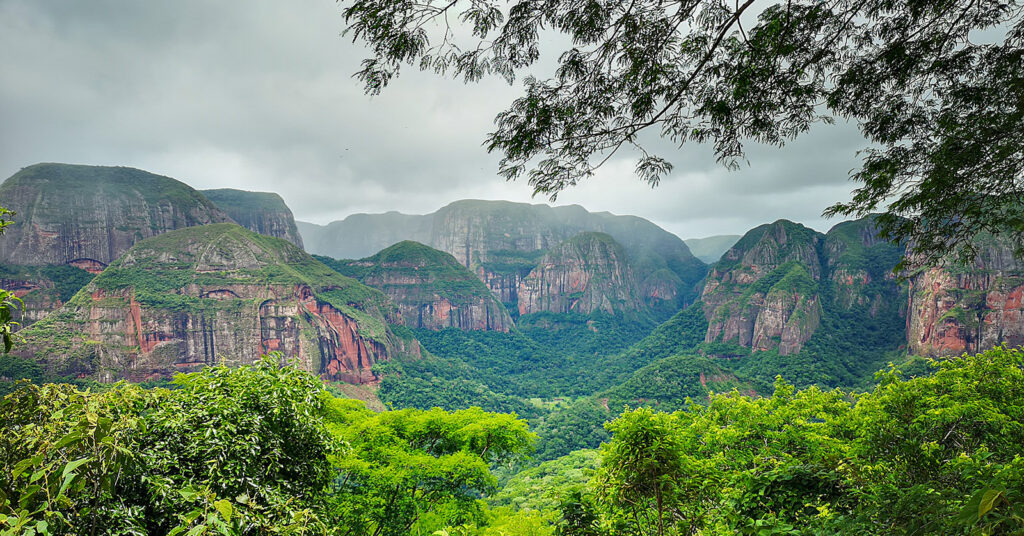
Ideally situated in the southern side of Amboro National Park is the spectacular Refugio Los Volcanes. Just two hours’ drive from the city of Santa Cruz this paradise is a place that has to be seen to be believed. The lodge is surrounded by giant sandstone cliffs, waterfalls and tropical jungles of Amboro National Park and it’s truly a world class destination.
3 DAYS / 2 NIGHTS
DAY 1: SANTA CRUZ / REFUGIO LOS VOLCANES
08:30 AM Approx. Hotel pick up and drive towards the lodge, this trip takes around 2 hours, before we stop at the Mirador of Refugio, here we stop for 15 minutes or so to take pictures of the incredible views before we swap vehicles to a small 4WD and drive 20 minutes down the valley to reach the lodge.
Here we will check into the rooms and visit a beautiful waterfall, where we can spend an hour or so swimming and taking photos of the surroundings
12:30 PM Lunch
Rest time to swim in waterfalls.
15:00 PM we will go on a 2 or 3 hour trek on one of the areas many trails, along the way will be learning about the plant life, surroundings, the park and observing birds /wildlife
17:30 PM Return to the lodge
19:00 PM Dinner
Optional Night walk
DAY 2: REFUGIO LOS VOLCANES
07:00 AM Breakfast
08:00 AM Depart for the trek into the Amboro National Park, this trek can take up to 7 hours and we trek through a range of rivers and the views are incredible, we will visit a few waterfalls along the way, check and set up the camera traps in the area and observe areas for birds and wildlife.
Lunch will either be at the lodge or a picnic at a secluded waterfall.
If time permits a small walk in the evening then dinner and optional night walk.
DAY 3: REFUGIO LOS VOLCANES / SANTA CRUZ
08:00 AM trek into one of the areas trails; here we will be looking for orchids, birds, which include Military Macaws and Condors, plus hopefully get sightings of Monkeys or even larger mammals, which are in the area.
14:30 PM visit the spectacular waterfalls
16:00 PM we check out of the room and depart the lodge; we will meet the main vehicle at the top of the Mirador of Refugio before returning to Santa Cruz.
18:30 PM Drop off in Hotel in Santa Cruz.
End of service.
Please note this is just an example tour plan, this itinerary completely depends on the tourists physical limitations, climate conditions and the tourist themselves, for example if you want to focus the tour on just bird watching this can be arranged.


A Guide To Amboró National Park
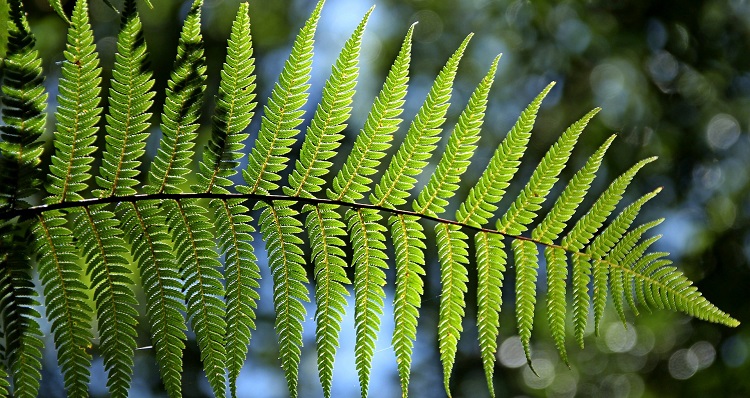
For those looking to escape the hustle and bustle of city life, Amboró National Park is a jungle paradise, perfect for unwinding, relaxing and getting back in touch with nature.
Located only 40 kilometres west of Santa Cruz , in the Andean foothills of Bolivia, Amboró spans a whopping 4,425 square kilometres stretching all the way to the borders of Carrasco National Park in the department of Cochabamba. The unspoiled park is also part of the Vilcabamba – Amboró Corridor that begins at the Vilcabamba mountains in Peru and extends all the way to Bolivia.
Noted for its rugged and varied topography, Amboró National Park lies within three distinct ecosystems: the foothills of the Andes, the northern Chaco, and the Amazon Basin. Nowhere else in the world do three such diverse environments coincide, making Amboró a unique host to a wide range of flora and fauna.
In 1984, with the help of esteemed conservation biologist Noel Kempff, British zoologist Robin Clark, and other notable researchers, Amboró was legally given the status “National Park” in order to protect the ecological hotspot from human settlements, hunting, mining and deforestation. One of the most biodiverse parks in the world, the preservation of Amboró is of immense importance to the scientific community.
Featuring beautiful walks, cascading waterfalls, dense vegetation, spectacular landscapes, fascinating archaeology and a great diversity of flora and fauna, it is no wonder that Amboró National Park is one of Bolivia’s greatest natural treasures.
Plants and Wildlife
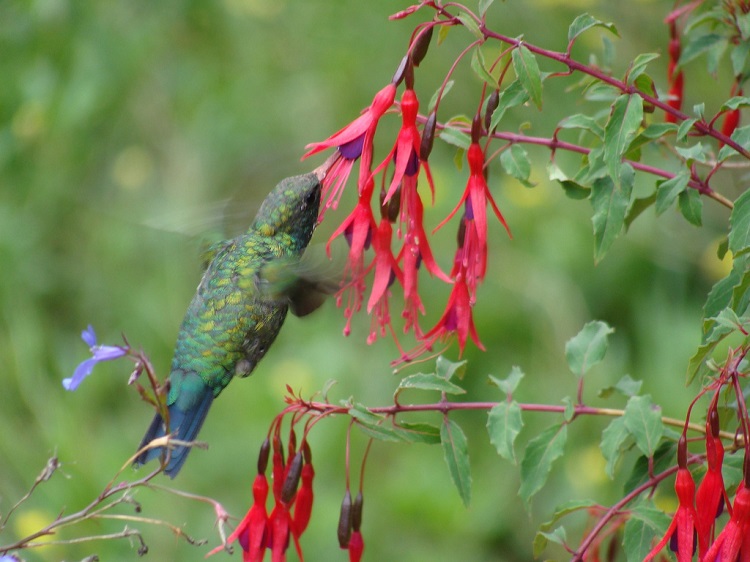
Photo Credit: Maartenzam
Home to over 2,659 species of plants, 177 mammals, 135 reptiles, 173 amphibians, and 812 species of birds, Amboró is one of the most botanically rich and wildlife abundant national parks in the world.
A large range of beautiful yet elusive mammals including tapirs, armadillos, spider monkeys, jaguars, giant anteaters, pumas, ocelots and spectacled bears, exist among the jungle’s dense vegetation, making it a prime location for wildlife watching.
Amboró is also a popular place in Bolivia to go birding. Featuring a staggering 830 species of bird (the highest of any park in the world), the pristine jungle contains 60% of the country’s avian population, making it the perfect place to spot blue horned curassows, spectacled owls, white-bellied hummingbirds, cock of the rocks, military macaws, cuvier toucans, and much, much more.
Characterised by great floristic diversity as well as presenting a high level of endemism, the current number of documented plant species in Amboró totals around 3,000. The large quantity of plants native to the area can be attributed to the park’s sharply divided topography, wide variance in elevation and unique geographical position at the junction of three distinct ecosystems. Made up of lowland forests, cloud forests, palm forests, tree-fern forests, cactus forests, tropical yungas forests, montane scrublands, pampas and much, much more, Amboró’s vegetational diversity is truly astonishing.
Due to difficult terrain and lack of infrastructure, much of Amboró has never been botanically surveyed, meaning there are likely many more plant and animal species yet to be discovered.
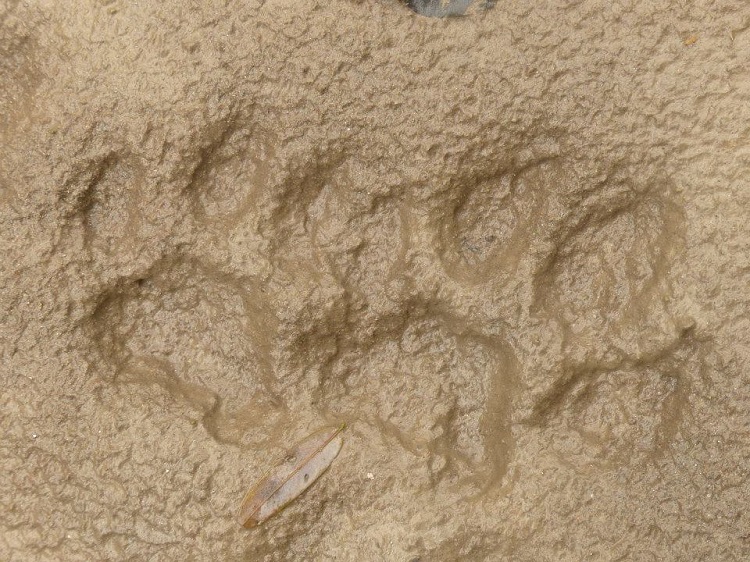
Photo Credit: La Chonta
With an altitude ranging from 300 up to 3500 meters above sea level, Amboró National Park has varying climatic conditions.
Following a bi-seasonal cycle, the highest temperatures can be felt between December and January, dropping to cooler temperatures in the months of July and August. At higher elevations the climate is temperate with frosts occurring in the coldest months. Characterised by a more pronounced topography, the foothills of Amboró is where you’ll experience hotter and more humid weather.
Rainfall varies between 600 mm and 4,000 mm annually with more rain being observed in the north than the south. The rainy season occurs between October and April with a maximum in January and the dry season extends from May through to September, with a minimum in July.
The best time to visit Amboró is in the dry season. Despite the cooler weather, this is the time when trails are less muddy and there are fewer mosquitoes hovering about.
North Side vs South Side
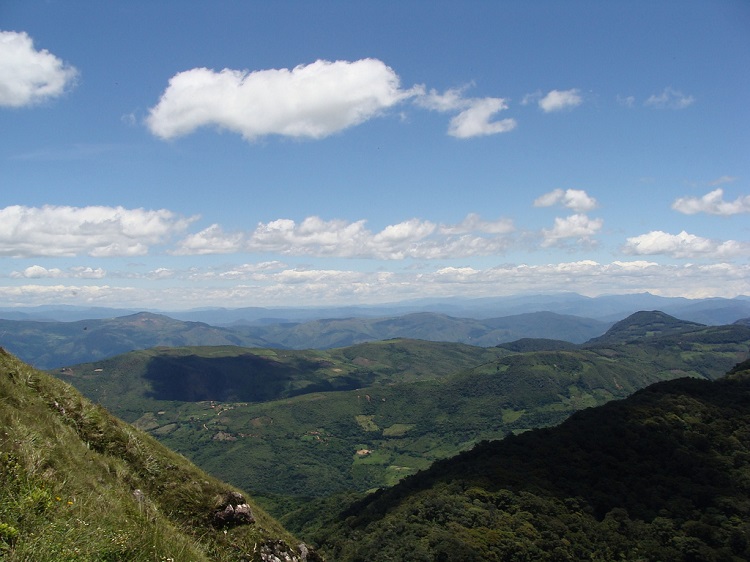
Amboro National Park is divided into two distinct sections; the highland region in the north and the lowland region in the south. Separated by a narrow trail called the “red line” the park is comprised of two administrative zones, the National Park encompassing 442,500 hectares and the Integrated Management Natural Area (IMNA) with 195,100 hectares. Effectively a multi-use zone, the IMNA was put in place to harmonize the conservation of biological diversity with the sustainable development of the local population.
Differing in landscape, vegetation, climate and wildlife, both sides of the park offer a breathtaking glimpse into one of Bolivia’s most beautiful regions.
Despite its beautiful towering rainforest and rich animal life, the northern side of Amboró sees very little tourism. Most tours are conducted 3km inside the “red line” where hikers can visit local communities to learn about the park’s rare species of plant and wildlife. Consisting of waterfalls, natural pools, rivers and streams, this portion of the park is a spectacular destination for those looking to explore the deepest areas of the green and mysterious jungle.
The south side of Amboró National Park is located in a mountainous area making access to the IMNA section of the park more difficult than on the north side. On the south side, vegetation is less dense, the climate isn’t as humid and there are fewer rivers and streams. The south side is also home to the rare spectacled bear as well as other species of endemic wildlife.
Popular Things To Do
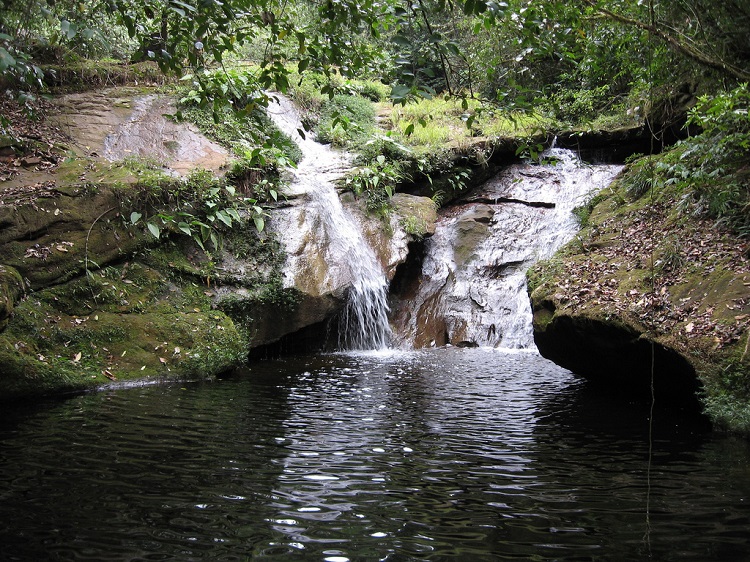
Photo Credit: Josie
- Visit the unique and picturesque region of Mataracú where you can try to spot rare animals like the giant sloth
- Cool off after a strenuous trek in one of Amboró’s many crystal clear waterfalls and mountain streams
- Rappel down Jardin de las Delícias waterfall
- Canoe, raft, fish and kayak along the river of Cajones del Ichilo
- Hike along the beautiful trails of La Orquídea, La Cascada, El Cóndor, Los Loros, Bosque Seco y Amboró
- Soak in spectacular panoramic views over the Volcanes mountain range at Mirador Loma Borda
- Observe giant trees, medicinal plants, ferns and much more on the well maintained “Las Palmeras” hiking circuit
- Go horseback riding along one of the many eco trails near the Chonta Carbones community
- See caimans and other jungle animals at Laguna Verde
- Walk along the “Dinosaurios” path where you can explore mysterious caves, enormous ravines and see dinosaur fossils with your very own eyes
- Explore Amboró National Park with experienced local guides learning about the park’s exotic flora and fauna
- Discover exotic bird species such as the Andian Condor, the Black-Chested Eagle, the Paraba Militar and the Emerald Tucan at Refugio Los Volcanes
- Stroll through Amboró’s beautiful cloud forest peering up at the giant ferns, a plant species so old it used to be dinosaur food!
- Spend some time in the Amboró Interpretation Center to learn about the different biological, geographic and cultural values of the National Park
- Have a picnic at the beaches of the Surutu River
Bolivian Life Quick Tip:
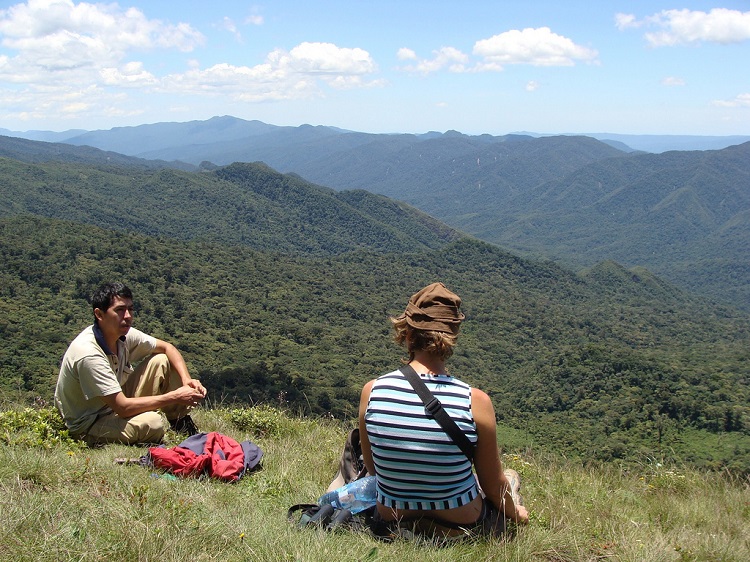
By law tourists may only enter Amboró National Park with a certified guide. There are plenty of tour operators serving the national park offering different programs for varying lengths of time.
The average cost for a good quality 2 day / 1 night tour is around $120 US per person which typically includes the following:
- Experienced local guide
- Accommodation in tent, cabin or lodge (depending on tour price)
- Meals and water
- Hikes and night safari
- Entrance fees
- Private transportation from Santa Cruz – Amboró Park – Santa Cruz
Most tours can be paid for in advance by credit card. You can book via email or on a walk-in basis directly in Santa Cruz or in the smaller towns of Samaipata and Buena Vista. If possible, try to organize a group of 4 or more people to travel with as prices become cheaper the more people sharing a tour.
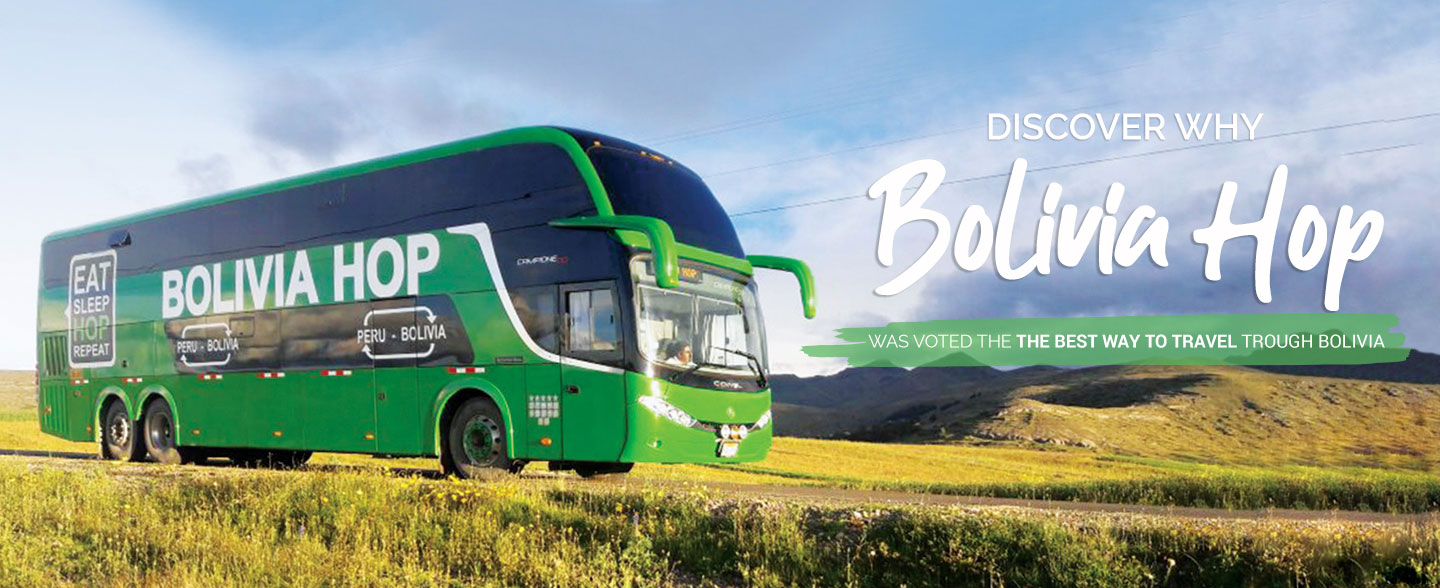
Getting There
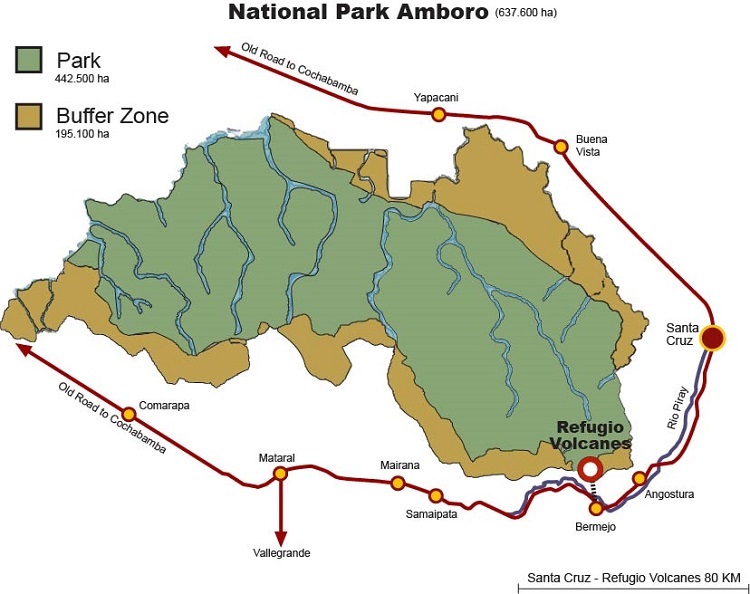
Access to Amboró National Park is made easy via two roads connecting the cities of Cochabamba and Santa Cruz. Only a three hour drive west of Santa Cruz, the National Park can be reached using either the old south road or new north road depending on which side of the park you wish to access:
Entrance to the South Side
Built in the 1950’s, the once asphalted southern road was left decaying after the opening of the northern route in the 1980’s. Today tourists must travel along a dirt road to access the south side of the park. The main access point to the more developed areas of the national park are via secondary gravel roads departing from the towns of El Torno, Samaipata, Mairana, Pampa Grande, Mataral an Comarapa, which are all located on the main highway.
A popular gateway to the south of Amboro is the pretty town of Samaipata. A 3 hour ride from Santa Cruz, you can reach Samaipata via taxi, public mini-bus, or private vehicle:
Public Mini-Bus: Take the no. 8 bus from the Santa Cruz bus terminal located on Avenue Omar Chavez Ortiz 1147 on the corner of Soliz de Olguin. Buses leave with at least 4 passengers and cost around $4 US for a one way ticket
Taxi: Shared taxis leave from calle Aruma and Grigota (just past second ring) costing around $4 US per person. You can book the whole taxi from Santa Cruz to Samaipata for around $18 US one way.
Private vehicle: Take the old road to Cochabamba up to Samaipata
Entrance to the North Side
The main access points to the northern side of the park is via the town of Buena Vista which is located along the northern Cochabamba / Santa Cruz road.
A 1.5 hour scenic ride from Santa Cruz, you can reach Buena Vista via taxi, public mini-bus, or private vehicle:
Public Mini-Bus: Leaving in the morning and evening from the old “terminal de buses” on calle Isos. Take buses heading to “Yapacani” and get off at Buena Vista’s main square. A one way ticket is around $3 US
Taxi: You can book the whole taxi from Santa Cruz to Buena Vista for around
Private vehicle: Take the new paved road to Cochabamba up to Buena Vista
Once in Buena Vista, it’s worth stopping by the Amboró Information Centre where you can gain up-to-date information on exploring the park
From Buena Vista into Amboró only 4×4 vehicles are recommended. Access to La Chonta, Macuñucu and to the Yapacaní River can be obtained via one of the several dirt tracks that lead off the main road.
Once inside the park, tourists can delve deeper into the jungle via the small trails and riverbeds surrounding the area.
Where To Stay
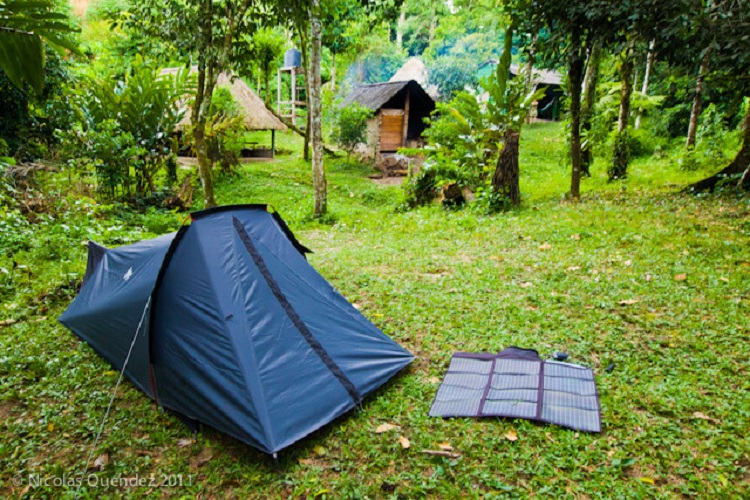
Ranging from basic camping to comfortable wooden cabins and well organised eco-resorts, the following accommodations are ideally located for excursions into the stunning Amboró National Park:
- Mataracú Tent Camp (north side)
- La Chonta Lodge (north side)
- Villa Amboró (north side)
- Refugio Los Volcanes (south side)
- La Yunga Eco Lodge (south side)
Travel Tips
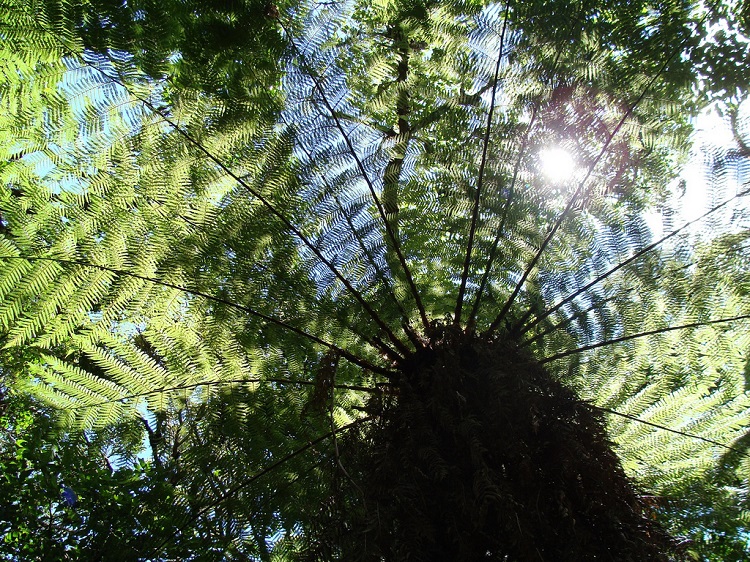
- Be prepared for varying weather conditions. Bring a flashlight, sunscreen, sunglasses, hat, long sleeve shirt, long pants, insect repellent, boots and waterproof clothing
- Be extremely careful during the rainy season when roads and tracks become muddy and treacherous. To enter one of the roads into the park you will need a 4×4, especially during heavy rainfall
- In wet weather, rivers can become difficult to cross within hours. It is possible to get stuck for 1 or 2 days while waiting for water levels to drop, something to be aware of if you have scheduled flights or other commitments
- When visiting Amboró, always bring a local guide and a map. Be sure to register with the park administration before entering and leave your itinerary
- To minimize the risk of malaria and insect bites, it’s recommended to wear long sleeved shirts and trousers, sleep under a mosquito net and to use insect repellent containing DEET, especially at night (see our guide to protecting yourself against mosquitoes ). We also recommend consulting a physician prior to visiting Amboró to get the most up to date advice on medications and vaccinations
- Do not feed or touch wildlife as it changes their natural behaviour and encourages interaction with humans
- Take only pictures, leave only footprints. Don’t remove anything from the park including plants, nuts, seeds etc.
Submit a Comment Cancel reply
Your email address will not be published. Required fields are marked *
YOU MAY LIKE
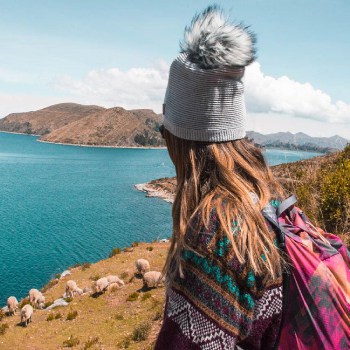
Get ready to discover
BOLIVIA in 2021
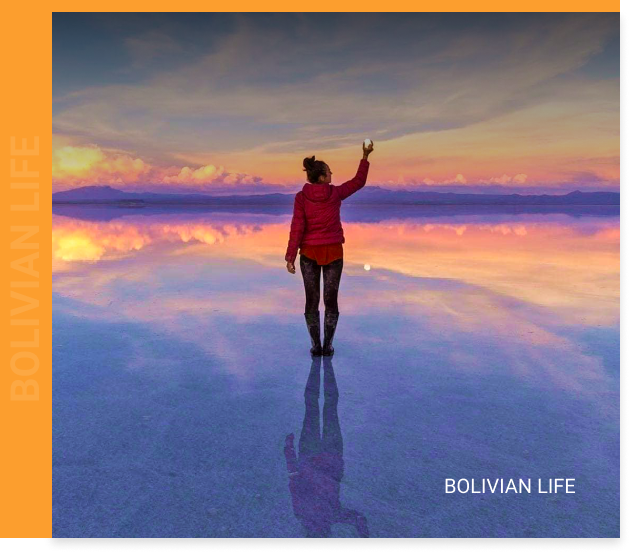
Sign up to stay up to date with all tips and recommendations for 2021 travel

Amboró National Park: Giant Fern Excursion
- Post author: Matt & Lia
- Post published: July 25, 2021
- Post category: Bolivia / Experiences / Hiking / Santa Cruz/Samaipata / South America
- Post comments: 0 Comments
The Amazon Rainforest holds an unimaginable amount of wildlife and beautiful scenery, and people travel from near and far to get a glimpse of it. When people think of the Amazon, Peru and Brazil often come to mind, but Bolivia is also an amazing place to experience the wonders of the Amazon and is a place that should not be disregarded. There are many jungle adventures to be had in the country, and visiting Amboró National Park is one excursion we definitely recommend.
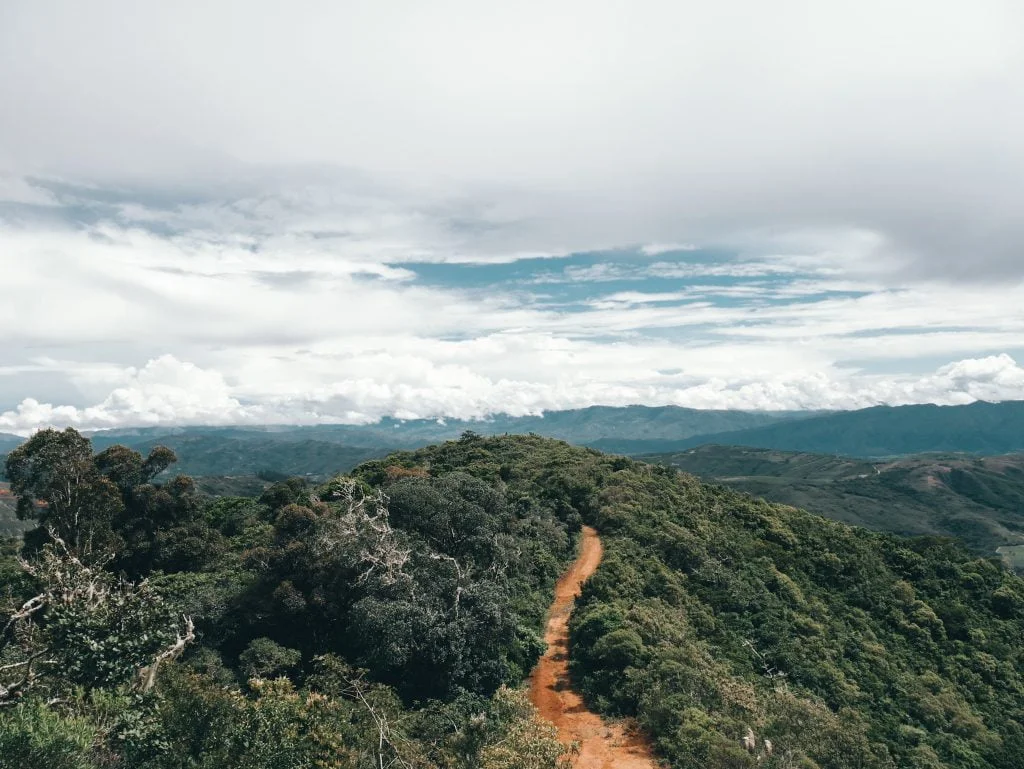
Amboró National Park offers an ecosystem unlike anywhere else due to the highly varied topography that ranges from the higher Andean foothills to the warmer and more humid Amazon basin. This unique aspect makes it one of the most biodiverse national parks in the world.
The park is in a convenient location, making it easily accessible from Santa Cruz de la Sierra , Samaipata , and other wonderful cities and towns located in the center of Bolivia. There are many ways to experience Amboró National Park, and below we will discuss the options we considered and our experience in the park.

Our Original Plan: A Night in Refugio Los Volcanes
Originally, we wanted to stay in Amboró National Park at Refugio Los Volcanes . This beautiful refuge lies right inside the border of the park and offers access to the amazing views, fun hikes, and complete tranquility. For a reasonable price, you get lodging, multiple meals, transport to the lodge from the park entrance, and ‘pathfinders’ to assist you on adventures.
While we were in contact with those working at the refuge, they were very friendly and accommodating. If you are thinking about staying here, we definitely recommend making reservations in advance by reaching them through their website . Our timing didn’t quite align with this option, and while we were bummed that we missed out on staying here, we experienced a great alternative.
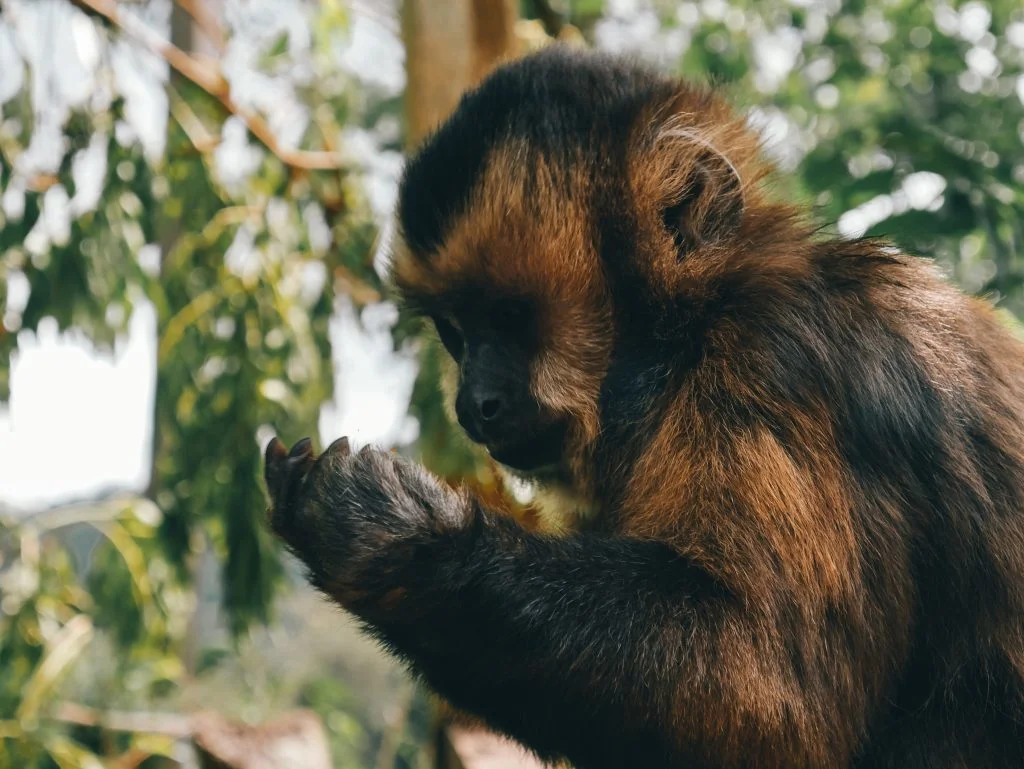
Plan B: Amboró National Park Day Tour from Samaipata
Tour overview.
Tour Cost: 180 Bolivianos per person
Duration: 6-8 hours, depending on hiking speed
Hike Distance: 8-9 miles (12-15 kilometers)
What to Bring: Comfortable shoes (they may get muddy and wet), sunscreen, bug repellent, rain jacket, lunch and snacks, water, camera
The Excursion
We left Santa Cruz de la Sierra and found ourselves in the lovely town of Samaipata. There, there are many tour operators that specialize in a variety of day tours to Amboró National Park. We opted to go with Samaipata Tours to see the giant ferns. This company also offers other tours, such as excursions to see the condors and the Samaipata fort.
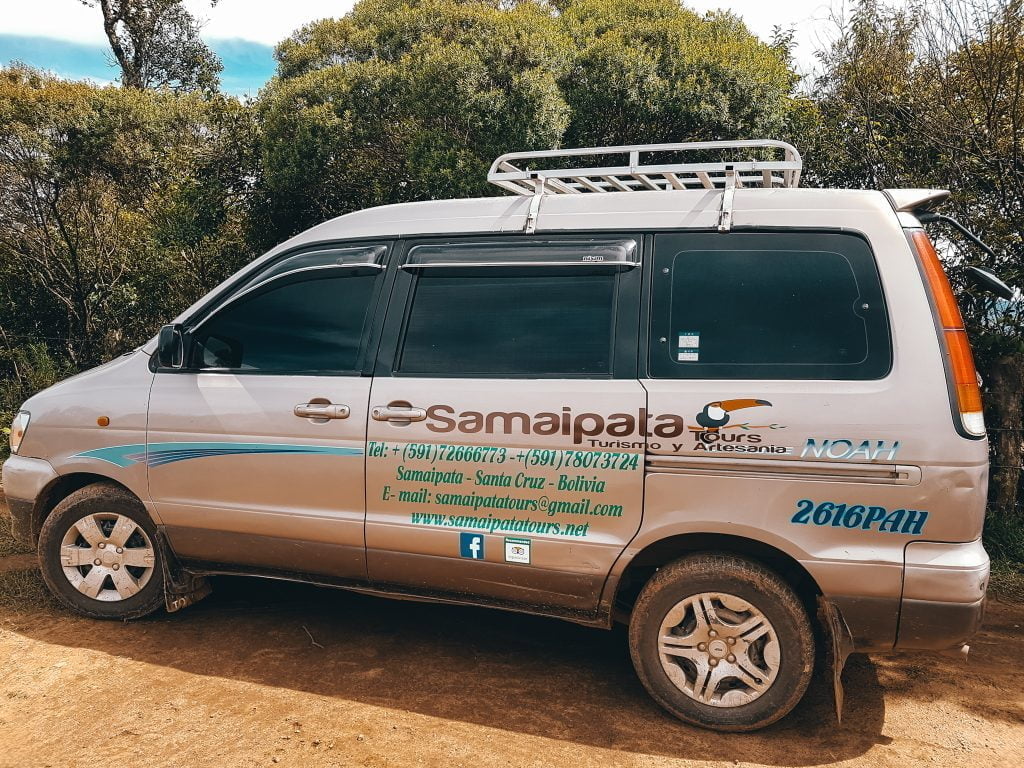
We left at 8:30 a.m., departing with our small group from the tour office. We drove about 45 minutes on the winding road up into the park, leaving civilization behind. It had been raining a lot lately, so the roads were a muddy. After the pretty drive through the countryside, we parked and began the ascent through the jungle.

All of the flora was lush and beautiful, but when we reached the giant ferns, we were amazed. These ferns are among the oldest plants on this planet. Some towered above our heads, blocking out much of the light that would otherwise flood the forest floor. Our guide provided much information about these unique plants. As we hiked, the forest was alive with the sounds of birds and rushing water.

We climbed higher, eventually leaving the forest behind and entering grassy fields. It was colder up here as there were no trees to protect us from the wind and rolling clouds left mist on our skin. We sat on the hillside for a while, eating our packed lunch and watching the clouds cruise through the valley.

We continued up the hillside, admiring the panoramic views before heading back down into the trees. The descent was much easier with the exception of the muddy spots. Towards the end of the hike, the sun came out, making for the perfect end to our excursion.
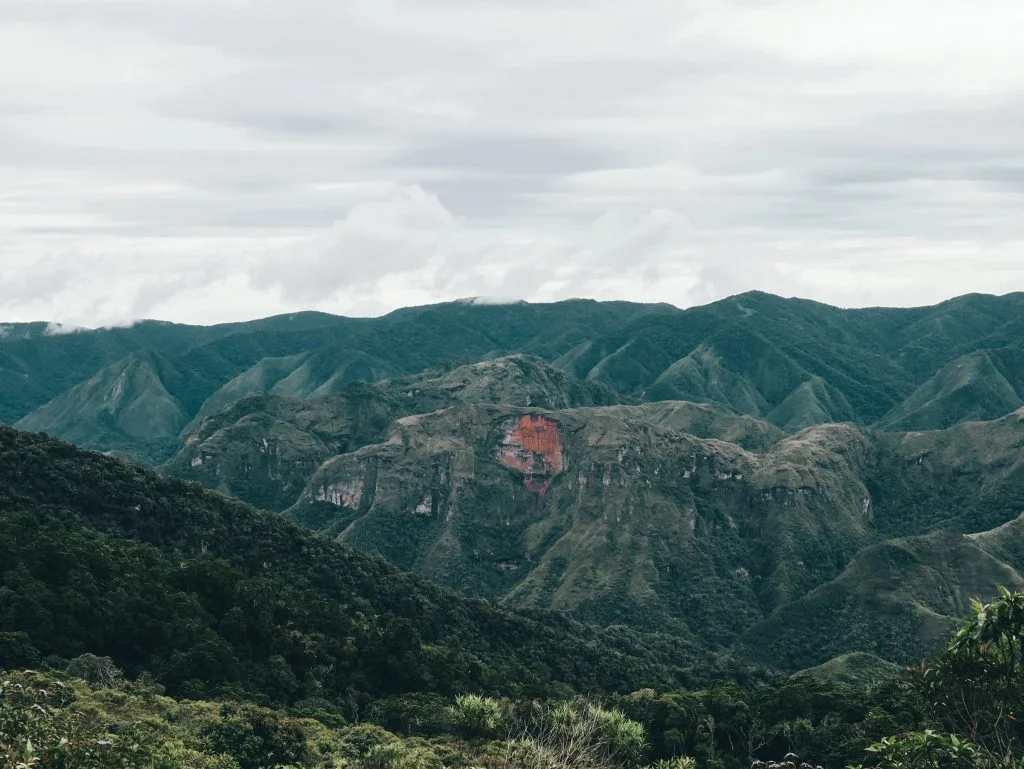
Like this Post? Pin it!
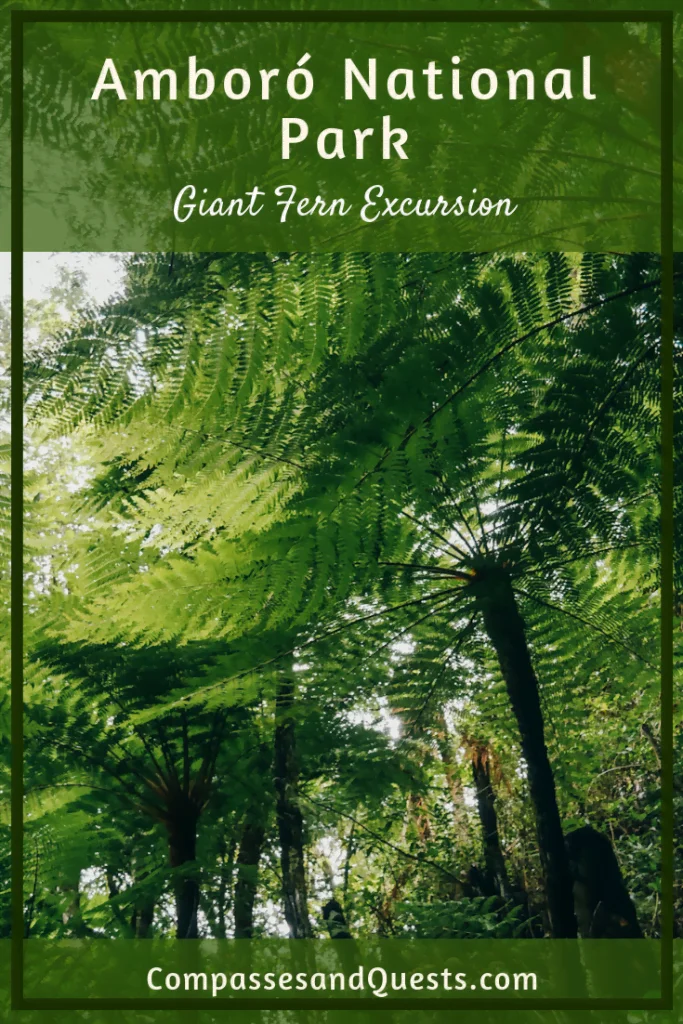
You Might Also Like

Waterfowl Lakes – Banff National Park

The Atomium – Visiting a Famous Brussels Attraction
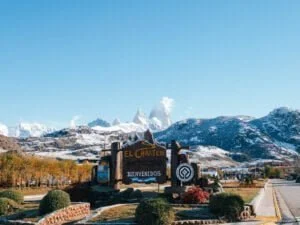
El Chaltén: A City Guide
Leave a reply cancel reply.
Global National Parks
National Parks of the World: Tourism, Accommodation, Routes, and Guides
Home » South America » National Parks in Bolivia
Amboró National Park and Integrated Management Natural Area
- 1.1 Geographical Location
- 1.2 Coordinates
- 1.3 Protected Area of Amboró National Park
- 1.4 History of Park Creation
- 1.5 Expansion and Category Change
- 1.6 Expansion of the Park
- 1.7 Establishment of the Integrated Management Natural Area
- 1.8 Objectives of Creating Amboró National Park and Integrated Management Natural Area
- 2.1 Physiography
- 2.2 Hydrology
- 2.3 Climate
- 3.1 Ecoregions
- 4.1 Cataratas del Jardín (Garden Waterfalls)
- 4.2 Mataracú
- 4.3 Laguna Verde (Green Lagoon)
- 4.4 Cueva de los Vencejos y Murciélagos (Swifts and Bats Cave)
- 4.5 Bosque de los Helechos (Fern Forest)
- 4.6 Volcanoes
- 5.1 Best Time to Visit
- 5.2.1 From Cochabamba to Santa Cruz
- 5.2.2 Access from Mairana, Mataral, and Comarapa (south)
- 5.2.3 Access from San Carlos and Yapacaní (north)
- 5.4 Infrastructure and Available Services
- 5.5 Safety Rules and Environmental Respect
- 6 Accommodation Options Inside and Around the Park
- 7.1 Current Conservation Challenges
- 7.2 Conservation Initiatives and Their Impact
- 7.3 How Visitors Can Help
- 8 Photo Gallery
The true sanctuary of biodiversity in Bolivia: the Amboró National Park , formally known as the Amboró National Park and Integrated Management Natural Area . With its vast spectrum of ecosystems, from cloud forests to savannas, it is a place of wonder for nature lovers, adventurers, and wildlife enthusiasts. This guide provides a comprehensive insight into what can be expected when visiting this protected Bolivian region.
Introduction to Amboró National Park
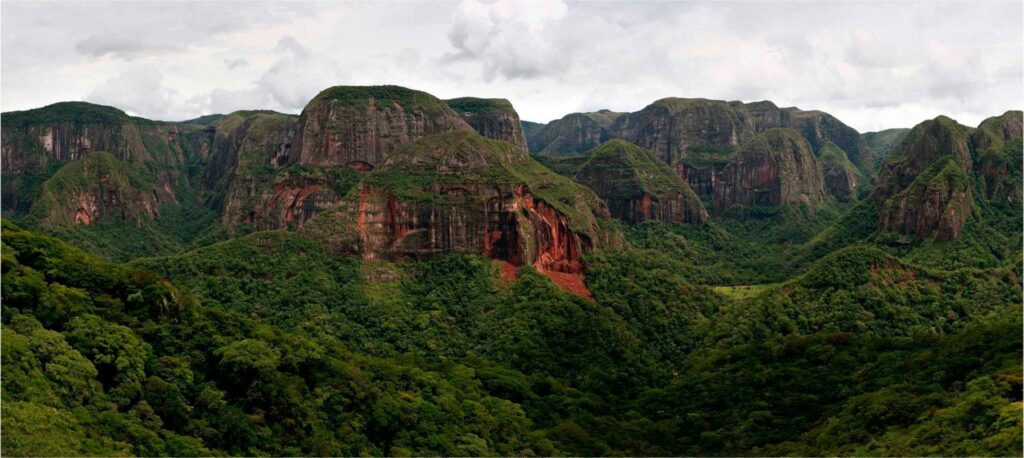
Geographical Location
The Amboró National Park and Integrated Management Natural Area is situated to the west of the Santa Cruz department in Bolivia. It spans across several provinces, including Manuel María Caballero, Florida, Ichilo, and Andrés Ibáñez. Furthermore, it involves various municipalities encompassing Comarapa, Saipina, Pampa Grande, Mairana, Samaipata, Buena Vista, San Carlos, Yapacaní, El Torno, and Porongo.
Coordinates
The park is located within a reference quadrant with the following geographical coordinates: Southern Latitude: From 17° 14′ to 18° 07′. Western Longitude: From 64° 46′ to 63° 28′.
Protected Area of Amboró National Park
The extent of the Amboró National Park and Integrated Management Natural Area has been mentioned in two distinct sources:
- According to Supreme Decree: 637,600 hectares. According to digital GIS (Geographic Information System) archives: 609,900 hectares.
It is important to note that slight variations in the figures may occur due to cartographic updates or more recent studies of the park’s territory.
History of Park Creation
Amboró National Park, also known as the "TCNL Germán Busch" Natural Reserve and in Spanish as the " Parque Nacional y Área Natural de Manejo Integrado Amboró ", had its beginnings on December 20, 1973, when it was established under Supreme Decree No. 11254. At that time, it was granted the category of Natural Reserve and bore the name "TCNL Germán Busch".
Expansion and Category Change
On August 16, 1984, through Supreme Decree No. 20423, a significant change in its category and designation took place. The natural reserve was officially transformed into Amboró National Park, in an effort to preserve its rich biodiversity and natural heritage.
Expansion of the Park
On October 11, 1991, through Supreme Decree No. 22939, a substantial expansion of the park’s area was carried out. Its extent increased considerably, reaching a total of 637,600 hectares.
Establishment of the Integrated Management Natural Area
On October 3, 1995, through Supreme Decree No. 24137, the extension of Amboró National Park was redefined, and an Integrated Management Natural Area (ANMI) was additionally established. This measure aimed to integrate nature conservation with sustainable resource use in certain areas of the park. Since then, the Amboró National Park and Integrated Management Natural Area has been an exceptional refuge for Bolivian biodiversity and a natural treasure of immeasurable value for the enjoyment of nature lovers, adventurers, and wildlife enthusiasts. Its history of creation and protection stands as a testament to Bolivia’s commitment to preserving its ecological wealth for present and future generations.
Objectives of Creating Amboró National Park and Integrated Management Natural Area
The creation of Amboró National Park and Integrated Management Natural Area, established with the purpose of protecting and conserving one of Bolivia’s most important natural treasures, is based on several key objectives:
- Protecting forested natural cover: The park seeks to preserve extensive areas of forests and jungles, as these ecosystems play a crucial role in safeguarding rivers and streams. Forest cover acts as a natural barrier against erosion and helps maintain water quality in the bodies of water flowing through the region.
- Conserving biological diversity: Amboró is a true gem in terms of biodiversity. Being a convergence point of three distinct ecoregions (the Amazon, the Andes, and the Gran Chaco), the park harbors an impressive variety of flora and fauna. Its creation aims to preserve and protect this unique biological richness.
- Preserving watersheds: Watersheds are fundamental to ecosystem balance and water supply for various communities and wildlife. Amboró National Park, by safeguarding its watersheds, contributes to maintaining a steady flow of water and protecting the health of the rivers and streams that originate or pass through its territories.
- Managing natural resources: Park conservation involves proper management of the natural resources present in its territory. The goal is to ensure sustainable and responsible use of resources, avoiding depletion and promoting long-term preservation.
- Promoting scientific research: Amboró provides a conducive setting for scientific research due to its high biodiversity and diverse ecosystems. The park’s creation also aims to encourage the conduct of studies and research that better understand the area’s natural wealth and develop more effective conservation strategies.
Physical Characteristics: Geography, Physiography, and Climate
Physiography.
Amboró National Park and Integrated Management Natural Area is located within the Subandean belt of Bolivia’s Eastern Cordillera. This geographical location bestows upon it a unique and diverse physiography.
- Mountainous topography: The park stands out for its mountainous topography, with numerous elevations and rugged relief. The presence of mountains and hills creates an impressive and varied landscape, offering panoramic views of great natural beauty.
- Steep slopes: The mountains within the park often feature steep slopes, contributing to the formation of rugged landscapes and deep valleys. These slopes provide diverse habitats for flora and fauna that adapt to different altitudes and environmental conditions.
- Altitude variations: Amboró encompasses a wide range of altitudes, leading to significant changes in climatic conditions and ecosystems. From the lowlands to the highest peaks, different types of vegetation and wildlife species can be found.
- Low hills in the south: In the southern end of the protected area, the presence of low hills is characteristic. These areas have more moderate altitudes compared to the higher mountains of the park, which may result in distinct ecosystems adapted to these conditions.
The diverse physiography of Amboró National Park contributes to its exceptional biodiversity and ecological richness. The different landscapes and altitudes within the protected area offer diverse habitats for a wide variety of flora and fauna species, making it a true nature sanctuary in Bolivia.
It is part of the Amazon River macrobasin, meaning its hydrographic network contributes to the Amazon River basin, one of the largest and most important in the world. Below are some of the main sub-basins present in the park:
- Río Grande or Guapay Sub-basin: The Río Grande or Guapay is one of the main rivers that flows through the park. It originates in the high mountains of Amboró, and along its course, it collects waters from numerous streams and tributaries, significantly contributing to the park’s hydrography.
- Río Mamorecillo Sub-basin: The Río Mamorecillo is also an important part of Amboró National Park’s hydrographic network. It originates in the high areas of the park and flows through its territory, providing a vital habitat for various species of flora and fauna.
- Río Yapacani Sub-basin: The Río Yapacani is another prominent river within the park. Its course also originates in the mountains of Amboró, and its presence contributes to the diversity and richness of the park’s ecosystem.
These sub-basins, along with other smaller streams and tributaries, form a complex and vital hydrographic network for the functioning and health of the ecosystems in Amboró National Park. The rivers and watercourses provide water and food for flora and fauna, and also play a fundamental role in protecting and preserving the park’s natural environment.
The park exhibits a variety of climates due to its diverse geographical location and the different altitudes within its territory. Below are the main climate characteristics in different areas of the park:
- Temperatures: During the months of November to March, temperatures can reach up to 35°C, creating a temperate and warm climate.
- Lower temperatures: In the months of June to August, temperatures significantly decrease, reaching around 10°C. This creates a cooler and more pleasant environment for visitors.
- Transition to dry valleys in the South: Annual precipitation in this region reaches around 1000 mm. This area tends to be drier compared to other parts of the park.
- Cloud forests of yungas and rainy sub-Andean areas: In these areas, annual precipitation is more abundant, reaching around 3000 mm. These regions experience a wetter and rainier climate.
- Part of the plain and foothills: Here, the average annual precipitation is around 1600 mm. This zone falls in the middle in terms of its humidity.
The variation in climatic conditions within Amboró National Park contributes to its incredible diversity of ecosystems and flora and fauna. These diverse climates allow for the existence of cloud forests, jungles, dry valleys, and other diverse habitats, creating a sanctuary for a wide range of species and making the park a captivating destination for nature and wildlife enthusiasts.
Biodiversity in Amboró
The park showcases remarkable diversity in ecoregions, making it a unique ecological site. Below are descriptions of the five ecoregions present within the protected area:
- Southwest Amazon Rainforests: This ecoregion covers a significant portion of the park and is characterized by its lush and dense tropical forests. Here, a wide variety of plant and animal species can be found, making it a primary refuge for biodiversity in the region.
- Yungas: The Yungas ecoregion is located on the eastern slopes of the Andes and is known for its high biodiversity and a unique blend of species from the Amazon and the Andes. In Amboró National Park, this ecoregion is manifested in cloud forests and humid areas where mist is frequent.
- Bolivian Tucuman Forest: This ecoregion is present in the mountainous and sub-Andean areas of the park. It is characterized by the presence of drier forests and shrublands and is home to species adapted to conditions of lower humidity.
- Chaco Serrano: The Chaco Serrano ecoregion covers the lower and drier areas of the park. It is characterized by its savannah and thorn forest landscapes, which contrast with the wetter and wooded areas of other ecoregions.
- Inter-Andean Dry Forests: This ecoregion is found in the higher and drier areas of the park, especially in areas near the foothills of the Andes. Dry forests and shrubs adapted to arid conditions prevail here.
The presence of these five ecoregions within Amboró National Park contributes to its remarkable biological diversity and makes it a privileged site for the conservation and study of the different ecosystems coexisting in this wonderful biodiversity sanctuary in Bolivia.
Amboró National Park is an invaluable reserve for the conservation of fauna in Bolivia and is an integral part of the Vilcabamba-Amboró Corridor, an area of great ecological importance. Within this nature sanctuary, diverse ecosystems are home to a remarkable diversity of animal species. Approximately 1,236 species of fauna have been recorded, some of which are particularly noteworthy:
- Andean Bear or Spectacled Bear (Tremarctos ornatus): This iconic species is one of the park’s treasures. The Andean bear, also known as the spectacled bear, is a flagship mammal of the Andean and mountainous forests of South America. Its presence in Amboró is an indicator of the health and balance of the ecosystems present.
- Jaguar (Panthera onca): The majestic jaguar is another of the great felines that find refuge in the park. Considered one of the most powerful predators in the Americas, its presence is essential for maintaining balance in the food chain and controlling populations of other species.
- Giant Anteater (Myrmecophaga tridactyla): Also known as the giant anteater, this species is one of the largest in its family. Its diet is primarily based on ants and termites, contributing to regulating the populations of these insects and their importance in the ecosystem.
- Horned Curassow (Pauxi unicornis): This is one of the most unique and distinctive birds in the park. Its striking crest makes it easily recognizable, and its presence in Amboró is a testament to the area’s importance for bird conservation in Bolivia.
- Military Macaw (Ara militaris) and Red-fronted Macaw (Ara rubrogenys): These two species of macaws are also worth mentioning. Their presence in the park showcases the diversity of birds that find refuge in these forests.
Amboró National Park is home to a rich diversity of flora, and it is estimated to harbor between 4,000 and 5,000 plant species. Although many studies are still needed to complete a comprehensive inventory, there is currently information about approximately 3,000 species. Below are some of the most relevant species present in the protected area:
- Giant Tree Ferns: In the cloud forests of Amboró Park, extensive patches of giant tree ferns such as Cyathea sp. and Alsophila sp. can be found. These majestic ferns add a touch of mystery and beauty to the shady and humid spaces of the park.
- Palms: The variety of palms in Amboró is impressive, and notable species include pachiuva (Socratea exorrhiza), asaí (Euterpe precatoria), and palma (Dictyocaryun lamarckianum). The endangered palma bendita (Ceroxylon sp. c.parvum) can also be found.
- Endemic Cacti: The park is home to several species of endemic cacti, including the Cereus colosseus, which is found only in this region, making it a species of high ecological value.
- Orchids and Bromeliads: Amboró is a paradise for orchid and bromeliad enthusiasts. These exquisite plants adorn the trees and forest floor, adding great beauty to the park’s flora.
- Economically Important Tree Species: The park boasts economically important tree species, such as mara (Swietenia macrophylla), known as Bolivian mahogany, tajibo (Tabebuia sp.), cedar (Cedrela sp.), mountain pines (Podocarpus spp.), and walnut (Juglans boliviana).
Tourist Attractions and Main Activities
Amboró National Park and Integrated Management Natural Area is an exceptional tourist destination for nature and adventure enthusiasts. Its vast biodiversity and diverse landscapes offer a wide range of attractions for visitors. Below are some of the most prominent tourist attractions in the park:
Cataratas del Jardín (Garden Waterfalls)
These stunning waterfalls are a natural spectacle that captivates visitors. The crystal-clear waterfall descends from the high mountains amidst lush vegetation, creating an unparalleled scene of beauty.
A picturesque village situated at the foothills of the park, Mataracú offers a unique opportunity to experience the traditional life of local communities and learn about their culture and customs.
Laguna Verde (Green Lagoon)
This beautiful lagoon is set in a dreamlike environment surrounded by forests and mountains. It’s an ideal place to relax and enjoy the serenity of nature.
Cueva de los Vencejos y Murciélagos (Swifts and Bats Cave)
An adventure for ecotourism and exploration enthusiasts. This cave hosts colonies of swifts and bats, offering a unique experience to observe these fascinating creatures in their natural habitat.
Bosque de los Helechos (Fern Forest)
A magical and mysterious place, this forest is home to giant tree ferns that create a lush and green canopy. Walking among these giants is like stepping into a fairy tale.
The park also houses some extinct volcanoes, which provide impressive panoramic views of the region. These volcanic formations add a touch of majesty to the park’s landscape.
These are just a few examples of the tourist attractions that Amboró National Park offers. Every corner of the protected area is an opportunity to explore and discover the natural and cultural richness that makes it so special. Visitors can enjoy hiking, bird watching, nature photography, and unforgettable experiences in a setting of unparalleled beauty and diversity.
Tips for Visitors
To ensure a safe and enjoyable visit to Amboró, it’s important to consider some tips and recommendations.
Best Time to Visit
The best time to visit Amboró depends on what you want to experience. For bird watching and wildlife observation, the drier months between May and October are ideal. However, for seeing the vegetation in its full splendor, the rainier months between November and April might be more attractive. Remember that temperatures can reach up to 35°C between the months of November to March.
Getting There and Getting Around the Park
There are several routes to reach Amboró National Park and Integrated Management Natural Area. The two main roadways connect Cochabamba with Santa Cruz, and from these, secondary roads lead to the communities within the ANMI. Here are some options for reaching the protected area:
From Cochabamba to Santa Cruz
Take the overland route that connects Cochabamba with Santa Cruz, an important route that passes through various localities. From this main highway, there are detours and secondary roads that lead to Amboró National Park. Access from Buena Vista or Samaipata:
If you are in Buena Vista or Samaipata, you can head towards the park from these localities. There might be signage or local guides that can direct you to the roads leading to the protected area.
Access from Mairana, Mataral, and Comarapa (south)
These towns also offer access possibilities to the park from the south. It’s advisable to gather information in advance about routes and road conditions to plan your trip safely.
Access from San Carlos and Yapacaní (north)
If you are in San Carlos or Yapacaní, you can take routes leading to the park from the north. Similar to other routes, it’s important to be well-informed about road conditions and potential difficulties that may arise during the journey.
It’s essential to remember that due to the nature of the park’s geographical location, some of the access routes may be secondary roads or may not be fully paved. Therefore, it’s recommended to plan the trip well in advance, be prepared for potential challenges along the way, and follow the guidance of local guides or authorities of the protected area to ensure a safe and respectful visit to the natural environment.
Entrance fees for accessing Amboró National Park and Integrated Management Natural Area for different categories of visitors:
It’s important to highlight that these prices may be subject to changes, and it’s advisable to verify the updated information before planning a visit. The prices are differentiated for foreigners, nationals, and students, reflecting the commitment to promote local and educational tourism in this protected area.
Infrastructure and Available Services
While Amboró is mostly wild, there are infrastructure and services available, including visitor centers, restrooms, and guide services.
Safety Rules and Environmental Respect
It’s essential to follow all safety rules and environmental respect guidelines to ensure a safe visit and preserve the park’s natural environment. This includes staying on designated trails, not feeding the animals, and carrying out all trash.
Accommodation Options Inside and Around the Park
There is a variety of accommodation options available inside and around Parque Nacional Amboró, ranging from campsites to luxury lodges. The choice depends on the type of experience you’re seeking.
Conservation and Protection of Amboró National Park
Despite its beauty and biodiversity, Amboró faces several conservation challenges.
Current Conservation Challenges
Amboró faces threats such as deforestation, poaching, and climate change. These challenges require ongoing conservation and protection efforts.
Conservation Initiatives and Their Impact
There are several ongoing conservation initiatives in Amboró, ranging from species protection programs to reforestation projects. These initiatives have a significant impact on preserving the park for future generations.
How Visitors Can Help
Visitors can contribute to the conservation and protection efforts of Amboró National Park by following guidelines provided at the park’s entrance.
Photo Gallery
Amboró National Park and The Elbow of the Andes
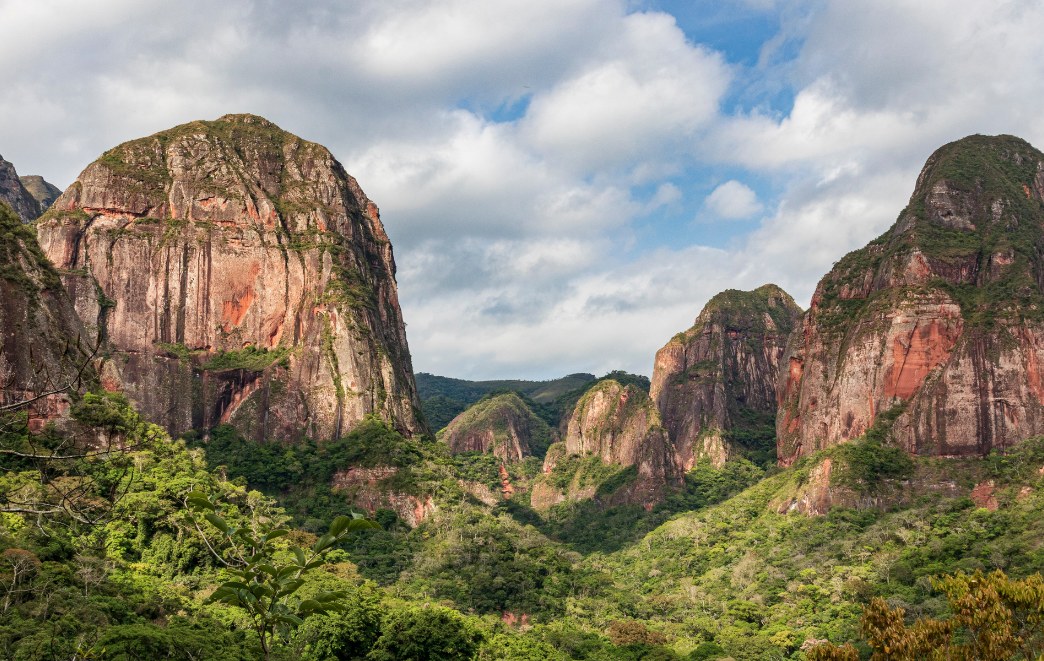
Amboró National Park in Bolivia is a special habitat for extensive wildlife due to the fact that it lies within three distinct ecosystems: the foothills of the Andes, the northern Chaco and the Amazon Basin. This makes it a “must-see” destination as this diverse biodiversity of three environments coinciding cannot be experienced anywhere else in the world.
With almost 3000 different plant species, Amboró National Park is one of the world’s most botanically rich national parks. It owes this authentic diversity to the variety of ecosystems which include lowland forests, palm forests, tree-fern forests, cactus forests, tropical forests, and cloud forests.
Amboró National Park is conveniently located only 40 kilometers west of Santa Cruz, which won’t drastically affect your travel itinerary. If you are seeking a natural getaway from city life, Amboró National Park is the perfect place to indulge in the lush green jungle and connect with mother earth. It boasts beautiful trails, incredible wildlife, breathtaking landscapes, stunning waterfalls, and more. It is definitely one of Bolivia’s many highlights.
We at Kuoda have summarized some important points to consider before embarking on your journey to visit this beauty firsthand.
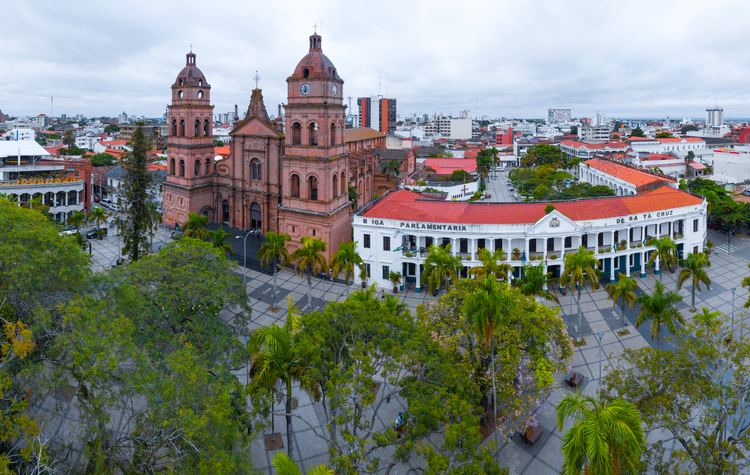
Amboró National Park is situated at the “Elbow of the Andes”, in the western part of the Santa Cruz Department of Bolivia. It is located only 40 kilometers west of Santa Cruz, in the foothills of Bolivia, making it a perfect add-on to your travel itinerary in Bolivia.
Amboró forms part of the Vilcabamba – Amboró Corridor. It begins at the Vilcabamba mountains in Peru and continues to Bolivia. It has an altitude of around 3000 meters in the westernmost part of the park, but most of the park elevates between 1000 meters and 2000 meters.
Biodiversity
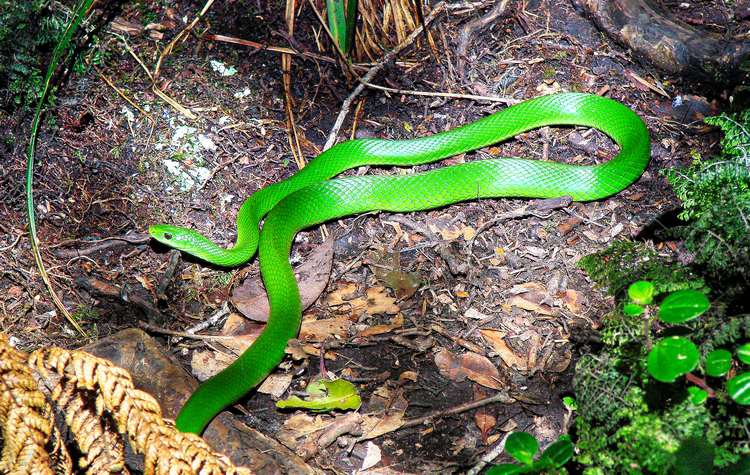
Amboró is one of the world’s most abundant national parks. It is home to almost 3000 different plant species, which can be attributed to the park’s distinctly divided topography. With different types of vegetation, giving life to a variety of forests, it attracts authentic wildlife to its diverse habitats.
Many big mammals can be observed here like armadillos, spider monkeys, jaguars, anteaters, ocelots, pumas, bears, and more. They feel at home in the dense forest-like vegetation, offering travelers the opportunity to see them in their natural abodes.
There are almost 830 different bird species found in the park, making Bolivia a top destination for birdwatchers. Expect to see hummingbirds, owls, macaws, toucans, curassows, and more – since the jungle hosts 60% of the country’s avian population.
Amboró is set on difficult terrain and due to the lack of infrastructure, a lot of the park has not been botanically surveyed yet. This makes it very exciting to know that there are many plant and animal species that still need to be discovered.
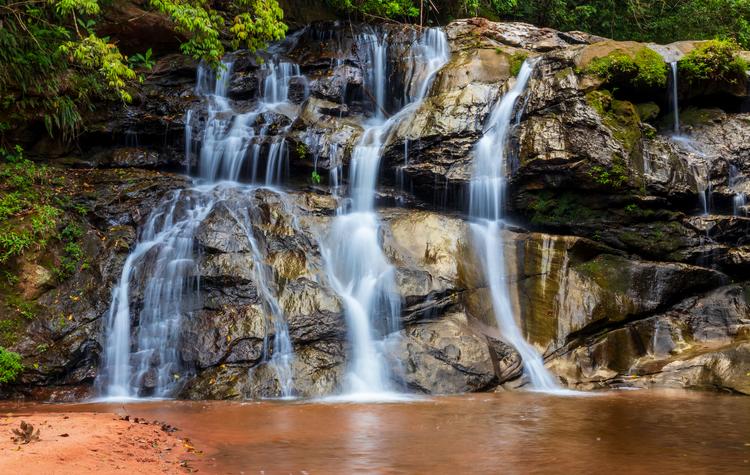
There are many things to do in Amboró, it all depends on your personal interests and the animals, plants or birds you are keen on seeing. For example, if you would like to see the giant sloth – visit the stunning region of Mataracú, or if you want to cool-off in a cascading waterfall – take a trek down to Jardin de las Delícias waterfall.
For the more adventurous types there are exciting outdoor excursions like canoeing, rafting, or kayaking along the river of Cajones del Ichilo. La Orquídea, La Cascada, El Cóndor, Los Loros, Bosque Seco y Amboró offers stunning trails for hiking lovers, and there is also the opportunity to hike over the Volcanes mountain range at Mirador Loma Borda for spectacular panoramic views.
Another exciting hike is the well maintained “Las Palmeras” circuit that takes you on a tour through giant trees and medicinal plants from the jungle. Go horseback riding if hiking is not for you, on one of the many eco trails near the Chonta Carbones community. For first-class wildlife viewing, visit the Laguna Verde, and see caimans and other jungle animals.
Explore mysterious caves, see dinosaur fossils, discover exotic bird species, stroll through the cloud forest, have a picnic at the Surutu River or visit Amboró Interpretation Center and learn about the different biological, geographic and cultural values of the National Park. There is literally everything for everyone to indulge in this natural wonderland in the elbow of Bolivia!
The difference between the North and South Side

It is easy to access Amboró through two roads that connect the cities of Cochabamba and Santa Cruz. Three hours west of Santa Cruz by car, the park can be reached using either the old south road or the new north road. It depends on which side of the park you want to access.
On the north of Amboró there are 50-meter-high waterfalls cascading into the crystal-clear pools of Laguna Verde, and the “Las Palmeras” trail showcases huge trees and medicinal jungle plants. Cajones del Ichilo can be reached by canoe or kayak and not far away natural caves “Cavernas de los Guácharos” can be found.
The southern region has mystical cloud forests, volcanoes and trails that lead travelers deep into the jungle, far away from civilization. Three incredibly high waterfalls can be reached through the well-marked hiking trails in Jardin de las Delicias. It is possible to stay overnight in huts or tents in the village of El Torno.

Travel with Kuoda
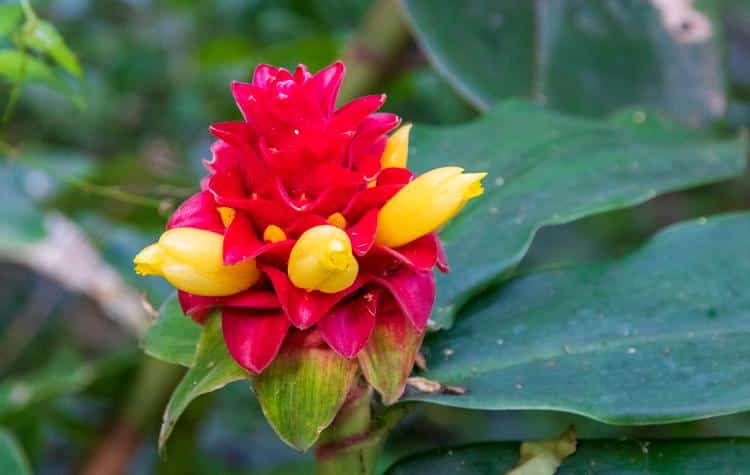
A visit to the Amboró National Park is an experience that can only be truly felt by doing it yourself. The park provides exceptional opportunities to view wildlife and birds in a way that cannot be expressed into words. It can be quite overwhelming to organize a trip like this, especially with so much contradicting information on the internet nowadays. We at Kuoda specialize in custom-made trips in South America, and we take into consideration the specific needs and requirements of every client. Get in contact with us today, and talk to one of our trip designers to start planning your trip as soon as possible.
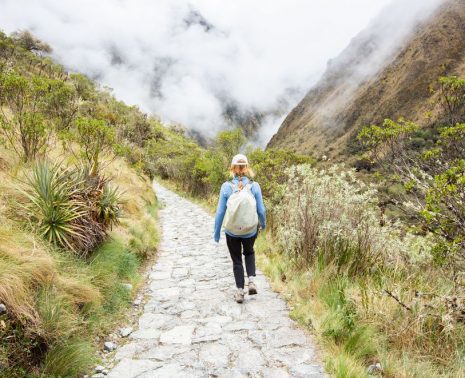
How To Sustainably Visit the Inca Trail on Your Next Trip to Peru
Trekking the legendary Inca Trail to Machu Picchu is a dream for many adventurers, but with that dream comes t...
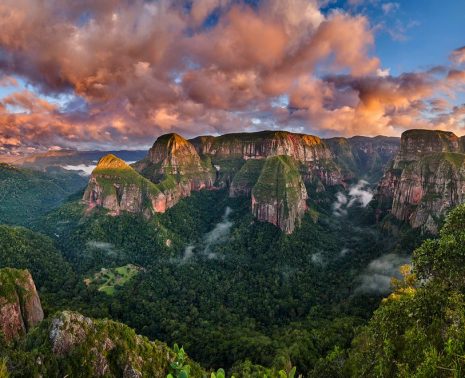
Exploring Bolivia’s National Parks: A Paradise for Outdoor Adventure Enthusiasts
Nestled in the heart of South America, Bolivia’s National Parks stand as a captivating tapestry of diverse l...
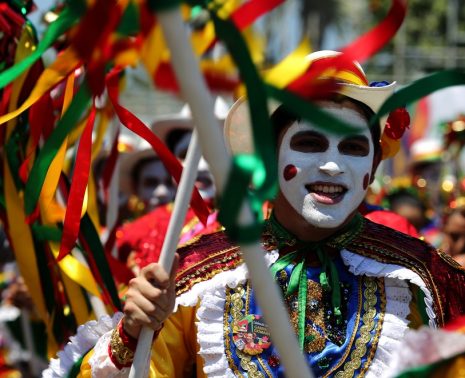
A Guide To Visiting Carnival in Colombia in 2024
Colombia, a vibrant tapestry of culture and color, welcomes visitors to immerse themselves in the fervor of it...
BROWSE THROUGH SAMPLE
Signature itineraries, adventurous mountain hikes, luxurious river cruises, or leisurely horseback rides through the countryside..
Every journey is uniquely handcrafted by Kuoda’s expert travel designers to your desire. Browse through a few sample itineraries below to get a preview of what your custom vacation to South America could look like.

THE AMAZON & MACHU PICCHU 10D / 9N
Discover Peru’s most bucket-list-worthy destinations. Explore a blend of magnificent, unspoiled nature and fascinating historic…

SIGNATURE PERU & BEYOND 9D / 8N
Embrace the once-in-a-lifetime opportunity to explore the most incredible destinations in a luxury tour of Peru. Walk on sacred grounds…

MACHU PICCHU LUXURY TOUR 8D / 7N
Masters of farming, engineering geniuses, and creators of a religion that combined features of animism and nature worship…


Guide To Samaipata & Amboró National Park Bolivia
Disclaimer : We may receive a small fee for any purchases made through links in this post. Learn more
A small town in Eastern Bolivia with temperate climate chilled out vibe. It’s easy to see why a fair few European immigrants have settled here and there’s certainly enough things to do in Samaipata to keep you entertained for a few days.

As we did, most visitors come to Samaipata Bolivia to venture into nearby Amboró National Park. A unique jungle paradise spanning a ginormous 4,425 km squared.
The collision of three distinct ecosystems: the foothills of the Andes, the northern Chaco, and the Amazon Basin means that Parque Nacional Amboró has a unique environment that isn’t found anywhere else on the planet.

More on what makes it so special and one of the best places to visit in Bolivia in a bit.
How To Get To Samaipata Bolivia
Santa cruz to samaipata.
From Samaipata from Santa Cruz or visa versa, the route is an easy one. Collectivos run all day between the terminal on the corner of Av. Omar Chavez Ortiz/Soliz de Olguin in Santa Cruz and the central plaza in Samaipata Bolivia.

Depending on the season the cost is $30-40B’s per person. The journey will take around 4 hours and the road.
Sucre to Samaipata
To get from Sucre to Samaipata you’ll need to take a night bus from the main terminal heading for Santa Cruz. Not all buses pass through Samaipata so make sure you double check. And you’ll need to set your alarm as you’ll be arriving at around 3/4am in the morning.
The bus will drop you on the main road, from which it’s a 10 minute walk depending on where you are staying. Hotels and hotels in Samaipata are not open 24/7 so you will need to book in advance and reserve a stay for that night so they know to expect you.

The night bus we took left Sucre at 5pm, arrived just before 4am and cost XB’s. It goes along the old south road so it was a very bumpy journey and we didn’t get much sleep, so we were grateful to slide right into bed at the other end.
Just an FYI if you’re not a fan of them, there’s lots of street dogs in Samaipata Bolivia. And whilst they were friendly during the day, it was a different vibe wandering through the streets at 4am.
Luckily it accumulated to no more than barking, but we had a couple of moments during the walk from the main road where we thought, shit, we’re gonna get bit here.

If you don’t fancy arriving early in the morning, there are day time buses to Santa Cruz from Sucre, so your other option is to take one of those and jump in a collectivo to come back to Samaipata. That way arriving at a more reasonable hour.
The buses going straight from Sucre to Santa Cruz go along the new north road so it’s also a quicker, more comfortable journey.
Where To Stay in Samaipata
Cheap & cheerful: hostal andoriña.
Simply put this place is a dream to stay at. Not only do they make a cracking breakfast with homemade bread, proper coffee and plenty of fruit, the owners are ridiculously helpful. There’s a cute little hideout on the roof. And if you like furry friends, their cat is an absolute cuddle monster.

Hostel Andoriña is where we stayed and absolutely loved it.
Mid-range: Hostel Serena
This hostel has the best ratings out of everywhere to stay in Samaipata Bolivia. It’s a little further out of the town centre (800m) but in return for that you get incredible views. They even have treehouses! The breakfast gets glowing reviews, as does the optional reasonably priced dinner you can opt in for.
People often choose to stay longer than planned at Hostel Serena .
Affordable Luxury: Finca La Vispera
We had lunch at this hotel in Samaipata so can tell you from experience that it’s a gorgeous place to stay. Individual chalets are dotted around the property, each separated by a beautifully landscaped garden.
Finca La Vispera tranquility and relaxation down to a tee.
Where To Eat in Samaipata
Our favourite restaurant in Samaipata was La Cocina. They do seriously delicious burgers. They also serve them to the bar down the road, La Boheme. It’s got a great vibe, great cocktails and live music many nights.

Somewhere else that does excellent food in Samaipata is La Pizzeria on Calle Arenales near the market. Fully rate this place.
Caffe Art is a cute little spot for breakfast or lunch. The courtyard is stunning. Again not the cheapest, not much is in Samaipata compared with the rest of Bolivia.

Which is why we ate at menus at quite a few of the local restaurants which you’ll find plenty of just off the main square.
Other places we were recommended but didn’t get chance to try are: Latina Café, Descanso en las alturas, Landhaus, Tierra Libre, La Oveja Negra and Hotel Paola.
Things To Do In Samaipata
So here’s the thing about things to do in Samaipata Bolivia. They’re not all that easy to get to. Well when we say not easy to, we mean cheap to get to.
Because while there are a few things to do in Samaipata town, the only way to get to the big hitters is to take a taxi. Because frustratingly there isn’t any public transport. And while it’s good for pockets of the taxi drivers, it’s not for anyone backpacking on a budget.
Sort it out Bolivia.
Las Cuevas Waterfalls
A series of three waterfalls with small hikes in between, you won’t regret hanging out here for a few hours. You can swim in the water and even jump off some off one of the waterfalls.

You’re not supposed to take food and drinks near the waterfalls (although we saw plenty flaunting the rule) so pack some in your bag if you’re likely to get peckish because there’s nowhere to buy food near here. There are toilets here though.
The entrance fee is 20B’s each ($3USD/£2.25GBP). And you’ll have to get a taxi there, it’s about 40 minuts from town.
If you do happen to have your own transport and are camping there’s a really nice enclosed spot with BBQ areas directly over the road from the entrance to Las Cuevas Samaipata.

We hired a taxi to first take us to Las Cuevas waterfalls in the morning, pick us up a couple of hours later, then drop us at Samaipata Fort. And then from there we walked back into town which is a pleasant 9km hike that’s mostly downhill. It took us just under 2 hours.
It is also easy to hitch hike back too, we had a few cars and trucks stop to offer us a lift.
For the taxi we paid $150B’s ($22USD/£17GBP).
So if you’re travelling on your own or as a couple, be worth making a few pals so you can split the costs of taxi fare. Again, easier to do in the high season when it’s busier.
El Fuerte de Samaipata
You’ll find plenty of mixed reviews about the Samaipata Fortress UNESCO World Heritage Site. We were fascinated by it, but equally we can see why if you’re not too interested in history you will just see a big rock.

But look beyond that and you’ll find a hugely important pre-Hispanic historic site. Divided into two areas, a religious part and an administrative part, the site of Samaipata Fort is huge.
From walkways you get a panoramic view over the main religious area which is the big rock with pre-Incan carvings. Then a marked path with information boards in Spanish and English takes you around the different Inca ruins in the administrative area.

We think you’d get a lot more from visiting El Fuerte de Samaipata if you hired one of the guides at the entrance. But because on top of having to take a taxi there and the entrance fee being 50B’s ($7.25USD/£5.65GBP) for foreigners, we opted not to pay another 100B’s for that.
Again would be cheaper to do if there’s a few of you.
There’s a restaurant here that serves traditional 2 course bolivian menus for 15-25B’s each and toilets.
Oh and your entrance ticket covers you for a entry to a museum in town about El Fuerte de Samaipata. Unfortunately it seemed to siesta time each time we stopped by so we can’t tell you if it’s any good or not. Opening times are 8am-12pm and 2-6pm.
Refugio Zoológico
We heard that visiting the animal refuge is a popular thing to do in Samaipata Bolivia. We opted not to however because we already had quite a packed Samaipata itinerary and we couldn’t find enough information about the ethics and specific actions of the place.

Not specifically in Bolivia, but unfortunately we’ve visited plenty of ‘refuges’ in the past that have just turned out to be zoos profiting off animals kept in poor conditions so we now err on the side of caution when it comes to animal tourism.
If you do go, please drop us a comment below to let us know how it was. The entrance fee is 20B’s each ($3USD/£2.25GBP).
It’s possible to walk there from town and there’s supposed to be a great place to grab an ice cream called La Vaca Loca on the way.
Samaipata Wine Tasting
We didn’t know about until the day before we were leaving Samaipata otherwise we’d have been all over it. You’ll find the winery on the path up towards Mirador de Samaipata, it’s hard to miss because it’s surrounded by fields of grape vines.

Tours happen at 9am, 10.30am, 2pm and 3:30pm but you’ll need to book in adance. Here’s the numbers for reservations: 69077787 or 76061430.
Again if you do a Samaipata wine tasting tour let us know how it goes in the comments so we can update this information for other fellow travellers.
There is also another place called Bodega Landsuá on the road up to the Samaipata fort.
Mirador de Samaipata
A little confusing to find if you don’t have the right information, this next what to do in Samaipata is actually inside a hotel resort called El Pueblito.
So once you reach that, you’ll need to go through the gates to the reception and pay the 20B’s entrance fee ($3USD/£2.25GBP). It’s pretty steep, the price, for what it is but a nice enough view and walk up is lovely.

Obviously if you happen to be staying here, you get to see this Samaipata viewpoint for free.
You can get lunch here if you fancy it and have the budget.
We opted to eat at another hotel we were recommended, back along the path to town and then off towards the right called Finca La Vispera. The menu is wholly vegetarian and all the produce is organically homegrown.

Prices per dish are 30-50B’s so it’s not the cheapest but worth it for the gorgeous setting.
Amboró National Park
The first helpful thing to know about Amboró National Park Bolivia is that you can’t enter without a certified guide. It’s the law, no wiggle room. Not that you’d want to anyway, there aren’t exactly clear paths in and out.
But obviously there’s a cost that comes attached to hiring a guide. If there’s more of you, which is easier when visiting during high season then prices are lower.

There’s lots of different types of tours that you can do to different parts of Amboró National Park, the most popular being the Bosque de Nubes (Cloud Forest) or Helechos Gigantes (Giant Fern) – it has two names – and the Condor Nest day hikes.
We chose to do the Cloud Forest hike so it’s the Amboró National Park tour that we have the most info about.

Of course we can’t compare it to the others but we’d highly recommend it. It was one of the best things we did in Bolivia and the scenery was out of this world.
Cloud Forest Samaipata
We did originally have 5 in our group. However unfortunately our hike got cancelled on the day we were supposed to do it due to bad weather. And the other 3 people booked on had to be somewhere else the next day so it ended up just the two of us.
We paid $500B’s which worked out at around $38USD / £30GBP each.
But prices v people with the tour company we went with – Tucandera Tours – are as follows:
1 person (450B’s) – 2 people (260B’s each) – 3 people (190B’s each) – 4/5 people (170B’s each) – 6/7 people (150B’s each). So you get the vibe. It’s similar with most tour agencies.

Of course you can, but you don’t have to get a group together yourself. You’ll see outside the tour agency offices signs like ‘tomorrow 2 pax’ so you’ll know they already have some people booked on a tour and that you’ll get a cheaper price.
The tour agencies also tend to call around the hostels too to let them know when they are looking for a few more to make it cheaper for everyone. So make sure you ask around.
Amboró National Park Tour
However do also just bear in mind that not all the Amboró National Park tour agencies are equal. We heard some guides can be a bit crap. We would recommend Tukandera Tours because the main guide and owner, Elva, is Bolivian and also a biologist.
Not only did she have a wealth of fascinating information but her excitement about everything nature was infectious. We never knew it was possible to get us so excited over plants. It’s also a small family run business.

We also heard good things about Chané Tours and Samaipata Tours too. But as always do check the most up to date reviews for tour companies before booking.
So as mentioned above this particular National Park in Bolivia is so special and unique because it’s where three diverse ecosystems collide. But more than that, because of the consequent precipitation cycle you get these huge flying air rivers tumbling through the sky with suspended waterfalls.

From afar it just looks likes clouds but close up we’ve never seen anything like it and were absolutely amazed.
Also as one of the most biodiverse national parks in the world, Amboró National Park is stuffed with tonnes of unique flora and fauna.
In fact, the scientific community has logged near 3,000 different species of plants, 135 reptiles, 173 amphibians, and 177 mammals including tapirs, armadillos, spider monkeys, jaguars, giant anteaters, pumas, ocelots and spectacled bears.

And then there’s the birds, all 812 different species of them.
Owing to how dense the jungle is you’d have to be very lucky to see any animals, although tracks in the mud are common. Our guide showed us photographs of jaguar footprints she’d seen recently.
But being as Amboró National Park has more bird species than any other National Park in the world and is home to 60% of the whole country’s bird population, they are however much easier to spot.
We saw Masked Trogons, Ruddy Quail-Doves, Woodcreepers, Tanagers, Thrushes Vultures, Toucans, Macaws and Hummingbirds. But cock of the rocks, curassows and spectacled owls are also common.

What’s more, as much of Amboró National Park is yet to be botanically surveyed so there’s likely many more species. Our guide was practically jumping around as much as a tiny frog we came across which she’d never seen before.
She excitedly took photographs and measurements in to log in the database in case no one else had either.
Giant Fern Hike Samaipata
The day starts at 9am with a bumpy 40 minute taxi ride (included in the tour price) to the closest entrance of Amboró National Park. It’s a full day and you’ll arrive back in Samaipata for around 5/6pm depending on the conditions and which route your guide takes.

We hiked a total of 12km, right up to the summit of La Mina, the mountain we were on. We’d enjoyed the hike immensely up to that point, learning about the jungle environment and winding our way through giant fern species so old they were once dinosaur food.
But it was standing on top of a Mina, above the clouds that blew us away because this is where the best views of the air rivers are.
It also did quite literally nearly blow us away on a couple of occasions so be sure to take an extra layer with you. It gets seriously windy up there.
It’s also colder in Amboró National Park than in Samaipata town so it’s best to wear long sleeves and leggings if you have them. It’s just because it’s such a constantly wet and damp environment.

You’ll also need a minimum of a litre of water, probably too. Unless you have a water filter bottle like we do, there’s plenty of streams to fll up in as you go. And you’ll need to take your own lunch, it’s not privded by the tour companies.
There’s a market in town where you can pick things up from. Or most hostels in Samaipata will make one for you if you order in advance.
It gets muddy in some parts but not a technically difficult hike so trainers are fine and are what we wore.

A waterproof jacket and dry bags are essential. And although we didn’t see any, mosquito spray. We wore suncream but you are under the canopy the majority of the time out of the sun.
The other tours you can take into Amboró National Park are as follows:
- Refugio los Volcanes
- Laguna de Volcanes
- Condor Nest
- The Che Trail
- Night time safari
Best Time To Go To Samaipata
The warmest months are during the rainy season October – April. The coldest months are May – September which is said to be the best time to visit Samaipata and Amboró National Park.

We visited in January, the rainiest month and as we said had to delay our cloud forest hike a day due to a huge downpour. But then when it was sunny, it was hot hot.
Where To Next in Bolivia?
- Find our mega guide on what to do in Santa Cruz here.
- Here’s our favourite things to do in the white city of Sucre.
Insurance For Travelling Bolivia
We never go anywhere without travel insurance – and neither should you.
This particularly goes if you’re planning to do any of the more adventurous activities above. World Nomads is our preferred choice for great cover and a no bullshit approach. They also provide cover if you’re already on the road.
Grab yourself a quick no obligation quote below:
Pin Me For Later…

Yorkshire born & bred, Sarah is a professional blogger who loves to travel. Pushing her boundaries with new adventures is her jam, so you likely won’t find her in one place for too long. Also a serious Marmite addict.

Rurrenabaque Bolivia & Choosing An Ethical Amazon Tour
Otherwise known as the gateway to the Amazon, Rurrenabaque is a must for your Bolivia itinerary. Here’s EVERYTHING you need to know to plan your trip.

Complete Guide to Visiting Santa Cruz Bolivia
Santa Cruz is Bolivia’s largest city, truly fascinating, yet attracts few tourists. Here’s why visit and what to do in Santa Cruz de la Sierra.

Trinidad Bolivia: How To See Pink River Dolphins
When planning a route for travelling around South America, Trinidad Bolivia simply has to be on it. There’s wild pink river dolphins. Need we say more?!

13 Awesome Reasons to Visit Sucre Bolivia
There are endless reasons to visit Sucre Bolivia, from its spectacular architecture to its fascinating history. Check out this run down of the top 13.
Submit a Comment Cancel reply
Your email address will not be published. Required fields are marked *
Hi, we’re James & Sarah

Full time backpackers turned vanlifers.
We’re here to provide you with valuable travel tips, kickass destination guides & serious vanlife inspiration to help you get your travel adventures off the ground!
Asistencias
- Viajes Éxito
Adquiere tu tour a Parque Nacional Amboró, Bolivia, con Viajes Éxito
Enamórate de los maravillosos paisajes de Bolivia con nuestros tours en Parque Nacional Amboró.
Viajes Éxito te lleva a la aventura en el Parque Nacional Amboró, Bolivia. ¡Descubre el mundo con nuestros tours exclusivos! Este parque, caracterizado por su clima templado a frío, alberga una asombrosa biodiversidad que te permitirá vivir experiencias inolvidables. No importa el idioma que hables, nuestros guías turísticos te ofrecen un servicio en español, quechua y otros idiomas para facilitar tu viaje. Adéntrate en los bosques vírgenes, explora ríos cristalinos y observa la impresionante fauna local. Escapa de la rutina y elige tu tour hoy con Viajes Éxito. Permítenos guiarte a través de este enclave natural extraordinario y sumérgete en la belleza salvaje del Parque Nacional Amboró. Tenemos precios increíbles para que vivas experiencias únicas disfrutando de un tour por Parque Nacional Amboró.
- Recomendaciones
- Comentarios
Tenemos precios increíbles para que vivas experiencias únicas disfrutando de un tour por Parque Nacional Amboró.
Acerca de los tours en Parque Nacional Amboró
¿En Viajes Éxito puedo adquirir tours en Parque Nacional Amboró?
Sí, en Viajes Éxito queremos ayudarte a vivir la experiencia que sueñas, por eso en nuestra página web encontrarás tours en Parque Nacional Amboró para que escojas el que más se ajuste a tus necesidades.
¿Los tours en Parque Nacional Amboró cuentan con guías?
Los tours en Parque Nacional Amboró suelen incluir guías expertos que te acompañarán durante el viaje, brindándote información y conocimientos sobre Parque Nacional Amboró. Esto te permitirá aprovechar al máximo tu experiencia, sin tener que preocuparte por la planificación y organización.
¿Qué tipos de tours ofrecen en Viajes Éxito?
Puedes elegir entre una variedad de opciones de duración, desde recorridos cortos de algunos días hasta aventuras más extensas de varias semanas. También hay tours temáticos disponibles, como tours gastronómicos, tours de naturaleza y aventura, tours culturales y muchos más. Esto te permite seleccionar el tour que mejor se adapte a tus intereses y preferencias.
Recomendaciones para tu tour en Parque Nacional Amboró
Ayuda a conservar el entorno natural Protege la flora y la fauna silvestre y su hábitat. No compres productos elaborados a partir de plantas o animales en peligro.
Ajustarse a la cultura y tradición del lugar que visitas Sé tolerante y respeta la diversidad; observa las tradiciones y las prácticas sociales y culturales del lugar. Evita los comportamientos que puedan ofender a la población local.
Favorece la economía y el desarrollo local en general Apoya la venta de bienes y servicios por parte de la población vulnerable del lugar de destino y promueve el comercio justo.
Respeta los recursos culturales Las actividades turísticas deben practicarse con respeto para conservar el patrimonio artístico, arqueológico y cultural de cada destino.
Datos de Parque Nacional Amboró
Tips para tu tour en parque nacional amboró.
- Decide qué lugares de Parque Nacional Amboró quieres visitar y el tipo de experiencia que te gustaría vivir
- Ten siempre algo de dinero en BOB, la moneda oficial de Bolivia
- Determina un presupuesto máximo para realizar tus tours en Parque Nacional Amboró, Bolivia
- Escoge la temporada de viaje acorde al tour que quieres realizar en Parque Nacional Amboró
Experiencias de nuestros viajeros
Diana Posada ¡El tour que realicé con mi familia en los parques temáticos fue asombroso! Los guías fueron amables, conocedores y se aseguraron de que todos nos divirtiéramos al máximo. Gracias a Viajes Éxito por brindarnos una experiencia inolvidable llena de risas y aventuras en familia.
Victor M. El tour de aventura y naturaleza que realicé con Viajes Éxito fue emocionante y enriquecedor. La organización impecable, los guías expertos y los paisajes impresionantes hicieron que esta experiencia fuera única. Gracias Viajes Éxito por llevarme a la aventura.
Carlos Palacio Comprar mi viaje con los tours incluidos a través de Viajes Éxito fue una excelente decisión. Los tours fueron muy bien organizados y enriquecedores. Estoy completamente satisfecho con mi experiencia y definitivamente volveré a confiar en Viajes Éxito en el futuro.
Encuentra todo lo que necesitas para conocer Parque Nacional Amboró
Reserva tu hotel aquí
Reserva tu vuelo aquí
Compra tu seguro aquí
Encuentra tu tour aquí
Renta tu carro aquí
Reserva tu paquete aquí
Enlaces de interés
- Tour en Cordillera Blanca
- Tour en Bahía Solano
- Tour en Cancún
- Tour en Cordoba
- Tour en Volcán Villarrica
- Tour en Huaraz
- Tour en La Ciudad Perdida (Teyuna)
- Tour en Los Ángeles
- Ofertas 2x1
- Vuelos Baratos
Variedad de ofertas
Compras seguras
Acumulas puntos colombia
Parque Amboro Zona Norte
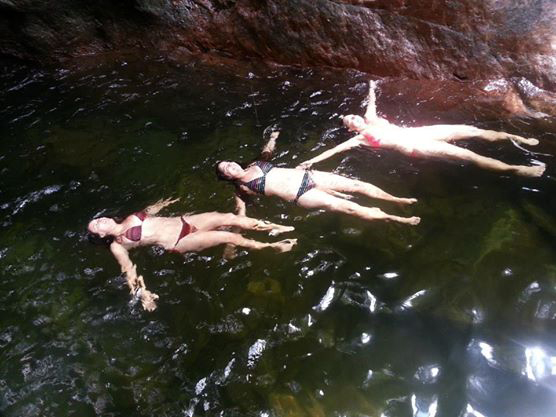
Parque Amboro Zona Norte
Para ingresar y pasar la linea roja del parque, como en casi todos los ingresos oficiales, primero se ingresa al ANMI (Aerea Natural de Manejo Integrado).una vez dentro del ANMI se atraviesan comunidades que casi en su totalidad estan pobladas por migrantes de las tierras altas en Bolivia. Estos pobladores parecen ser de muy bajos recursos ecomicos, pero en realidad casi todas las familias aqui asentadas poseen como minimo 50 hectareas de terreno en el ANMI, mas otros bienes de considerable valor economico.
En algunos caso el camino de ingreso para los vehiculos termina a pocos metros de la linea "Roja", La linea roja es un sendero habierto a machete para marcar la divicion entre las comunidades y la parte central del parque. En otras palabras, la línea roja separa el la Aerea Natural de Manejo Integrado del parque donde esta asentadas las comunidades en (ANMI) con la parte central del mismo donde no se debe permite asentamiento humanos ni actividades depredadoras.
Casi todos los tours Parque Amboro zona norte van a una zona tropical con bosques lluvioso amazonico En la parte norte del parque nacional Amboro es posible ingresar varios kilometros despues de la linea roja (con las autorizaciones necesarias). despues de cruzar las comunidades. Algunos de los ingreso oficiales en la parte norte del parque son: Mataracu, La Chonta, Saguayo, Ichilo y Macuñucu..Agunos de estos ingreso no son viables para operar eco-tours debido a razones que no se pueden/deben ser expuestas en esta website.
Tours Al Parque Amboro Zona Sur; Es posible combinar las zona sur del parque Amboro con Samaipta, en tour de 2 dias 1 noche. Los Lugares as visitar serian Refugio Volcanes, El Fuerte y el museo de Samaipata.En la zona sur del Amboro en la parte de manejo integrado se cuenta con un lodge para la comodidad de los visitantes La zona sur del Parque Nacional Amboro es topografia variada de montañas y principios de colinas no dificil de caminar por la la parte baja o paralelo a algun rio o arroyoTambien es posible avanzar por los "filos" de las colinas para llegar a pequeños valles mas dentro de la linea roja.
Lo que llama mas la atencion a los visitantes que aprecian estos lugares es la calidad de el bosque y la diversidad propia de esta zona de bosque primario.
Acerca de aves, el Parque Nacional Amboro contienes segun estudios mas especies de aves que toda todo el pais de Costa Rica. Las aves en la selva son facil de escuchar pero dificil de ver por la densidad del bosque
En mamíferos esta parte del Amboró es rica ya que contiene todas las especies propias de la Amazonia
Eco-Turismo parque Amboro Zona Norte
Tours al Parque Amboro zona norte ingresan mas adentro del mismo parque. Se cruza las comunidades generalmente en vehiculo y se llega asta cerca de la Linea Roja
Cuando los tour son a La Chonta el pernocte puede ser en cabañas rusiticas de la comunidad. Ultimamente esta cabanas no han tenida un matenimiento adecuado y por ahora el sitema de agua no esta habilitado, el año pasado el fuego quemo gran parte de la zona por lo que Amboro Tours no ofrece esta opcion por el momento.
En cuanto a el ingreso denominado Mataracu el pernocte es generalmente en Camping.
Parque Amboro Zona Norte Ingresos
Fotos mataracu la chonta saguayo macuñucu ichilo, un breve programa estandar - parque nacional amboró zona norte.
Lado Norte del Parque Amboró - Itinerarios Tours en el parque Amboró Un Breve Programa para actividades eco-turisticas en visitas guiadas en el Parque Nacional Amboró Zona Norte Este programa/itinerario es una explicacion de las actividades de 1,2 o 3 días en los tours al Parque Nacional Amboró
1er día. - Estos Tours al Parque Amboró comienzan generalmente a 8H00 en la ciudad de Santa Cruz. En caso que sea desde BuenaVista seria9H30 aproximadamente.
Si es desde la ciudad de Santa Cruz la primera parte de este viaje dura aproximadamente 1.5 horas (100 km) asta BuenaVista pueblo cercano al Parque Nacional Amboró. En este pueblo nos encontramos con el coordinardor de Amboro Tours y guía local.
En BuenaVista se cambia a un automóvil 4x4. Desde BuenaVista se sigue por un camino de tierra que puede durar alrededor de 1.5 Horas o 45 Km aproximadamente.. En este período de tiempo debemos cruzar rios y/o arroyos y al mismo tiempo las comunidades que estan al rededor del nucleo del parque.
En temporada de lluvia, si ha llovido demasiado y el nivel del río es demasiado alto o la arena esta muy blanda. En este caso se tendra que caminar o seguir por otros medios pasando otros rios o arroyos asta el lugar de camping o cabañas.
Si no contrató a un porteador, debe llevar su mochila y sus botellas de agua hasta las cabañas/campamento.
Después de almorzar podran dejar su mochila grande, para empezar la otra caminata, pero esta vez en los senderos de la selva amazónica, solo con una mochila chica. Deben llevar consigo siempre sus cosas de valor. Los senderos en la selva se encuentran en la parte del parque sin asentamientos humanos.
Si tomaste el tour de 1 día 0 noches y se ha llegado a los senderos sin atraso tendras una caminata en los senderos de aproximadamente 3.5 horas en la selva o menos.
Si su recorrido es de 2 días o más, por la noche también es posible realizar algún trekking. (Siempre con el guía) Este trek también es en la selva amazónica. Por la noche, en los senderos y todos los lugares donde miras están oscuros. Especialmente sin no hay a luz de la luna. Por la noche si pones un poco de atencion se puede sentir diferentes aromas de las flores/plantas. Algunos animales eligen la noche para caminar, por lo que es posible que tenga más posibilidades de ver algunos animales salvajes. (Nunca garantizamos ver ningún animal silvestre. Es necesario llevar linterna de cabeza y/o linterna de mano.
2do día .- Usualmente en tours de 2 dias o mas es posible tener un trekking temprano de 2 horas antes del desayuno.. y otro trek mas largo despues del desayuno. Las caminatas pueden ser por diferentes senderos.
En los paseo de 2 dias 1 noche se tiene que hacer el almuerzo en el lugar de camping para estar cerca del la salida..
3er Dia .- Cuando los tours al parque N. Amboro son de 3 dias 2 noches o mas dias, .el dia en el centro, en este caso el 2do dia es enteramente dentro del parque, asi que tienen mas tiempo de organizar caminatas mas largo a destinos o lugares mas adentro del parque y si puede ser tambien pernoctes en distintos lugares de la selva...Para todo esto es preciso un buen guia, porsupuesto.
En cualquiera de los casos anterriores el último día de estos recorridos por el parque Amboró, la caminata de regreso al vehículo es después del almuerzo alrededor de las 15H00.
El arribo a la ciudad de Santa Cruz es aproximadamente a las 19H00
Por favor leer los términos y condiciones de nuestros servicios
La unica fuente de esta breve descripcion de los recorridos de 1, 2 , o mas dias, es Amboro Tours
Las condiciones climáticas adversas o bloqueos de caminos y otros por razones de convulciones sociales pueden afectar el/los programas
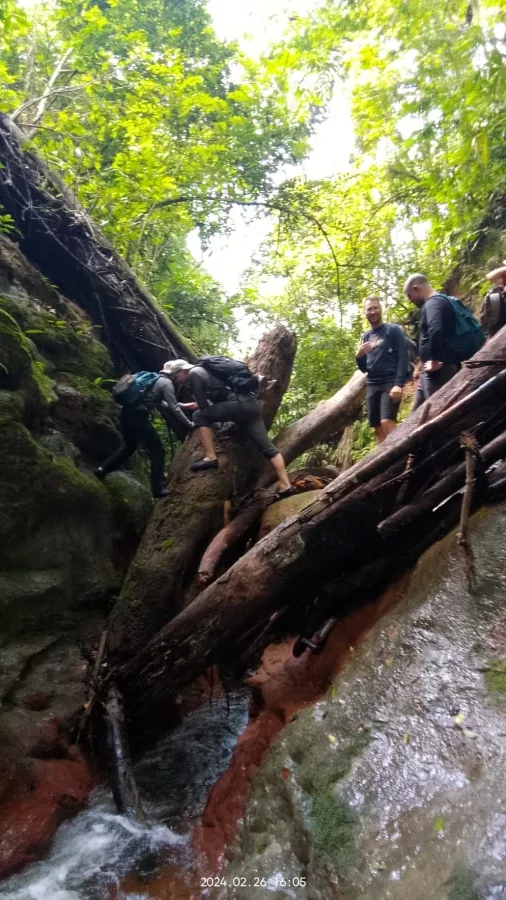
Booking-Form
Itinerarios: - sintetizado de 1 dia + - 1 dia 0 noches - 2 dias 1 noche, videos parque amboro zona norte mapas mataracu la chonta - que traer .... recomendaciones . precios / tarifas , itinerarios - parque amboro zona norte, 1 dia 0 noches itinerario.
Itinerario Un Dia Cero Noche
Desde la ciudad de Santa Cruz
1 Dia 0 Noche
A las 08:00 lo recogemos de su lugar para llevarlo sobre carretera pavimentada pasando por varias poblaciones del norte del departamento de Santa Cruz hasta una población ubicada aproximadamente a 1 ½ horas de distancia.
En ese punto de encuentro estar el resto del equipo de Amboro Tours esperando por nosotros para hacer posible este paseo.
El Parque Amboro zona norte tiene cinco lugares principales de ingreso ellos son; Mataracu, La Chonta, Macuñucu, Saguayo e Ichilo.
En algunos el ingreso distante que en otros pero casi todos se encuentran a la misma distancia. Los más cercanos en kilómetros serian Saguayo y La Chonta y el mas distante es Ichilo.
De acuerdo a las condiciones de acceso, la solicitud del visitante y el tiempo disponible, se determinara el lugar de ingreso.
Lo que el visitante busca ver y experimentar siempre es lo mas importante y se tratará de complacerlo de acuerdo a la posibilidades.
Desde este punto de encuentro, empezaremos otro recorrido en vehículo 4 x 4, sobre caminos de tierra u asfalto, este recorrido puede ser de 40 minutos para llegar a cruzar el rio ''Surutu'' e ingresar al area de las comunidadades del parqueo ANMIA (Área Natural de Manejo Integrado Amboro). Que en su gran mayoria son gente venida de las tierras altas de Bolivia. Ya en el parque Nacional Amboro se cruzan varios rios y arroyos, todos sin puentes.
Usualmente, el camino para vehículos termina cerca del campamento de los guardaparques o de la “Línea Roja”Visitante en el amboro mataracu.La Linea Roja es un sendero abierto a machete en algunas partes visible a simple vista.
Esta linea roja separa las comunidades de de la parte central del parque Amboro donde ya esta prohibido el asentamiento humano y /o cualquier actividad que signifique daño a la naturaleza. Casi todas las caminatas son dentro de la '' Linea Roja''
El lugar hasta donde llega este segundo transporte dependerá de las condiciones del camino en el momento de realizar el viaje, las cuales pueden variar de un momento a otro debido al clima entre otros factores.
Durante todo este tour en el parque Amboro estaremos con la asistencia de un guía que nos explicara acerca de la exuberante vegetación y vida salvaje del parque. Las preguntas del visitante sobre este medio ambiente siempre serán bienvenidas.
En tours de un dia se escogera el ingreso que mas se ajuste al tiempo disponible y otros factores que puedan incidir directamente en el paseo
Apesar que los paseos de un dia al parque Amboro resultan cortos, teniendo en cuenta el tiempo necesario para llegar y para salir. Si es posible formarse una vision general de lo que significa esta reserva natural y sentir lo importane que es la Amazonia
Aunque queda claro que no se garantiza en ningun momento, ver algun rastro de o el avistamiento de ningun animal, si existe grandes posibilidades de observar mamiferos chicos y grandes o ¡tambien los monos se podran dejar ver. Tenga en cuenta que ver un animal salvaje en su habitad no es un derecho si no un privilegio
Para poder sentir este medio ambiente tan especial necesitamos estar con el máximo silencio y la máxima tranquilidad posible y así poder tener nuestros principales sentidos alertas como ser el oído, olfato y vista.
Después de esta maravillosa e inolvidable experiencia, caminaremos de vuelta al lugar donde dejamos el vehículo, para retornar por el mismo camino que llegamos y después seguiremos hasta la ciudad de Santa Cruz donde lo dejaremos en la puerta de su hotel.
Fin de nuestros servicio al parque Amboro zona norte
Favor leer los Terminos y Condiciones de nuestros servicios
Amboro Tours es la única fuente original del presente Itinerario
Amboro Tours también ofrece tours de menos o más días a este destino.
Condiciones climatológicas adversas, o convulsiones sociales pueden cambiar el itinerario original.
Tenga presente que este itinerario puede variar o no cumplirse en su totalidad por factores del clima y/o las condiciones del los caminos y de los ríos o arroyos.
También tenga presente que este tour puede convertirse o ser una aventura donde percances pueden pasar por lo que se necesita mucho espiritu aventurero y de explorador.
Este tambien preparado para protegerse del sol (bloqueador solar, gafas, sombrero o gorra, camisa manga larga, pantalón largo y otros) y de la lluvia (vestimenta impermeable)
Tambien tenga presenta que no puede sacar nada del parque (plantas o semillas)
2 Dias 1 Noche Itinerario
Itinerario de Dos Dias Una Noche
Parque Amboro jZona Norte
Itinerario de 2 dias 1 noche
2 Días 1 Noche
Este tour al Parque Amboro Zona Norte empieza a as 08:00 lo recogemos de su lugar para llevarlo sobre carretera pavimentada pasando por varias poblaciones del norte del departamento de Santa Cruz hasta una población ubicada aproximadamente a 1 ½ horas de distancia.
El Parque Amboro zona norte tiene cinco lugares principales de ingreso ellos son; Mataracu, La Chonta, Macuñucu, Saguayo e Ichilo.
Desde este punto de encuentro, empezaremos otro recorrido en vehículo 4 x 4, sobre caminos de tierra u asfalto, este recorrido puede ser de 40 minutos para llegar a cruzar el rio ''Surutu'', ''Yapacani'' u otro e ingresar al area de las comunidadades del parqueo ANMIA (Área Natural de Manejo Integrado Amboro). Que en su gran mayoria son gente venida de las tierras altas de Bolivia. Ya en el parque Nacional Amboro se cruzan varios rios y arroyos, todos sin puentes.
Este primer dia las caminatas por los senderos, piscinas y / o arroyos puede durar 1 o 2 horas. Teniendo encuenta que sin dificultades mayores en el camino se llegara dentro de la linea roja alrededor del medio dia.
Aunque queda claro que no se garantiza en ningun momento, ver algun rastro de o el avistamiento de ningun animal, si existe la posibiidad de observar huellas de mamiferos grandes y si tenemos "suerte" tambien los monos se podran dejar ver.
En horas de la noche antes o después de la cena tendremos también la oportunidad (opcional) de una corta expedición nocturna con linternas para observar tratar de observar mamíferos. Favor recordar esto al guia.
En caso de la ausencia de servicios higienicos, solicitar al guia cavar un pozo.
Pernocte en el parque
La idea es empezar el dia temprano escuchando los sonidos, del la selva. En las primeras horas de la mañana es cuando hay mas actividad de las aves y animales.
La hora del desayuno debe ser acordada la noche anterior con el guia.
Despues del desayuno esta la opcion de una larga caminata de 4 horas almorzando en el camino con lo cual esta caminata puede durar cerca de 6 horas. O se puede hacer una corta caminata de 2 horas o menos.
Lo que se haga el segundo y ultimo dia de este paseo estara en base a las actividades ya realizadas el dia anterior, y del lugar donde se haya pernoctado y por supuesto del clima.
Por lo general existen senderos predeterminados en la selva donde en ocasiones es posible caminar por un gran circuito donde incluye miradores al interior del parque para obervar un verdor impenetrable y que pareciera que nunca acaba.
Donde no hay senderos las caminatas se realizan por los arroyos. El tipo de los recorrridos dentro de la linea roja siempre varian dependiendo del campamento de guardaparques que se escoga para ingresar y como este es un itinerario estandar no especificamos con precision estos senderos.
En viajes de dos dias tampoco no se garantiza la observacion de ningun animal, ya que ellos por lo general no tienen ningun interes en hacerse ver por los humanos. Salvo ocasiones cuando algunos animales estan en celo o de mal humor como lo pueden demuetran los monos arañas o Marimonos. Como tambien en la epoca de noviembre en los caminos habiertos es probable ver taranturalas de mas de una especie.
Es recomendable que el visitante comunique a la oficina de Amboro Tours que clase de experiencia quiere pasar en el Cascada del parque amboro mataracuparque Amboro, como asi tambien debe recordarselo al guia que lo/a acompañara durante todo el recorrido. Esto ayudara a que se tomen ciertos pasos hacia ese cometido, pero en ningun momento se garantiza se garanatiza que asi sea
Dos dias no es mucho tiempo en este lugar para los visitates que aprecian o que no tienen problemas en tener un contacto tan cercano con la naturaleza que tambien puede implicar, garrapatas, mosquitos y otros insectos. Pero si se puede llegar a visitar ciertos lugares con relativo tiempo.
El encuentro con el vehiculo que los sacara de vuelta por lo general se lo programa para horas 15:00 o 16:00.
caminaremos de salida al lugar donde dejamos el vehículo para retornar por el mismo camino que llegamos y después seguiremos hasta la ciudad de Santa Cruz donde lo dejaremos en la puerta de su hotel.
Fin de nuestros Servicios. Gracias.
Fin del tour al parque Amboro zona norte
Tenga presente que este itinerario puede variar o no cumplirse en su totalidad por factores del clima y/o las condiciones del los caminos y de los rios o arroyos.
Tambien tenga presente que este tour puede convertirse o ser una aventura donde percances pueden pasar por lo que se necesita mucho espiritu aventurero y de explorador.
“Solo lleve sus fotografias y deje solo sus huellas”
Que Llevar ? Parque Amboro Zona Norte
Para los tours al Parque Amboro Zona Norte No traiga cosas que no vaya a necesitar durante el viaje por que en ocaciones la caminata puede ser mas de lo esperado
Tours de 1 Dia 0 Noches
- Bloqueador Solar
- Gorra o Sombrero- (Ojo ¡! NO USAR DEBAJO DE LOS ARBOLES O RAMAS ¡!)
- Gafas para el sol
- Ropa para protegerse del frio
- Ropa para meterse a las piscinas. Aunque por lo general no hay tiempo suficiente
- Zapatos especiales para la selva. Sandalias para el agua
- Ropa para protegerse de la lluvia
- Repelente para insectos
- Camisa y pantalón largo Suficientemente gruesas para protegerse de insectos
(Colores claros (Los mosquitos son atraidos por los colores oscuros)
- Documentos Personales de Identificación. (Original) EN BOLSAS A PRUEBA DE AGUA
- Medicamentos especiales para su persona
- Bolsas plásticas para las cosas que no se deben mojar
- Comida extra de acuerdo a su preferencia
2 Dia o Mas (Ademas de los ítems para 1 Dia)
Pernocte en camping; Mochila grande, camping (Tienda), Colchoneta, Bolsa de
Dormir. Tabletas Purificadoras de agua
- Objetos de uso personal; Toalla, papel higiénico +. Cargadores, Baterías
- Sandalias y/o Zapatos livianos para caminar en arroyos o rios
- Lámparas De mano y cabeza - Con baterías
- Mosquitero para la cabeza ( Muy útil si no se usa repelente para la cara)
- Ropa suficiente y un par de trousers que se conviertan en shorts y sequen rapido
Cuando llueve la ropa se puede mojar con el agua.
Recomendaciones Tours Al Parque Amboro
Eco-Turismo – Aventura
1. No explore en solitario
2. Siga las instrucciones del guia
3. No toque los insectos o reptiles
4. Ponga las cosas que desea mantener secas, en bolsas plasticas
5. Tenga cuidado en RESBALAR y caer cuando cruza rios u arroyos o alrededor de las piscinas naturales
6. Trate de no saltar de un lugar a otro
7. Dentro de las carpas. No fume o prenda velas, no ingrese con zapatos
8. No levantar rocas o troncos
9. No bote basura que no es biodegradable, incluidas colillas de cigarros
10. En ríos arroyos, piscinas de las reservas naturales no use detergentes
Enfermedades Tropicales.- Para minimizar el riesgo de la Malaria u otra enfermedad
topical picaduras de insectos, recomendamos el uso de camisas y pantalones largos
y el uso de repelentes
Mente positiva.- Durante el o los tours particularmente, en areas remotas,
le recomendamos ver las cosas desde un punto de vista positivo. Tome las situaciones
adversas con calma.
Aventura.- Tenga presente que este tour se puede convertir en una aventura donde
accidentes pueden pasar por lo que es necesario tener un espíritu aventurero.
Desodorantes.- Trate de no traer sustancias de olores fuertes
Cambios climáticos.- Especialmente las lluvias pueden hacer cambiar el itinerario
Equipaje.- El o los visitantes tendrán que cargar su propio equipaje, equipo de camping
Agua y posiblemente se tendrá que ayudar al guía con el traslado de alimentos
Tours al parque Amboro zona Norte Precios / Tarifas - Dolares Norte Americanos Precios por persona-Pernocte en Camping
3 Días 2 Noches
2 visitantes; $ 220.-
4 visitantes; $ 180.-
2 Días 1 Noche
2 visitantes; $ 159.-/
4 Visitantes;$ 120.-
1 Día 0 Noche
- 2 visitantes; $120.-
4 Visitantes;$ 77.-
Los precios incluyen
Pick Up centro de la ciudad de Santa Cruz y vuelta al mismo lugar Comidas, (Ver detalles) Transporte - Guía local de habla hispana - Agua embotellada Trekking por los senderos de la selva y también algún trekking nocturno corto.
- Valor de la entrada (Bs 100.- por persona)
- Traslados Aeropuerto o Terminal de Buses
- Cualquier otro elemento no mencionado en la lista incluida.
- Seguro Contra accidente
Más visitantes en un grupo significa mejores precios por persona
Es posible que tengamos más personas para unirse al grupo. Si este es el caso, el costo por persona es más económico. .
Lea atentamente nuestros términos y condiciones de nuestros servicios .
(Si confirma este recorrido, deberá firmar nuestros Términos y condiciones cuando se reúna con nosotros)
Por lo general, para reservar un recorrido, debe pagar una parte del costo del recorrido por adelantado. Pero si reserva un día antes o en el último minuto / reserva en línea, debe pagar el costo total del servicio el primer día del recorrido. Necesario pagar en efectivo. En Bs (BoB) o $ (dólares norteamericanos).
Puede pagar para confirmar el tour un adelanto con tarjeta de credito mediante un enlace de Tab Otra forma de pagar un adelanto para confirmar un tour con anticipación es a través de Western Union con una transferencia de $ 50 o $ 100.-.
El saldo se debe pagar en efectivo el dia que empieza el tour.
También se puede hacer a través de transferencias bancarias. Pero las comisiones del banco pueden ser más altas. Si estás en Bolivia es posible un depósito bancario sin pagar comisiones.
RECOMENDACIONES Y CONDICIONES:
Pregunta por los detalles de los mismos antes del inicio del tour.
Está prohibido el transporte y/o uso de drogas según las leyes bolivianas.
Las condiciones climáticas adversas pueden cambiar el programa original.
Las convulsiones sociales pueden afectar el itinerario original.
Otros servicios no incluidos en esta Tarifa
Amboro park - Videos
Amboro National Park - Map
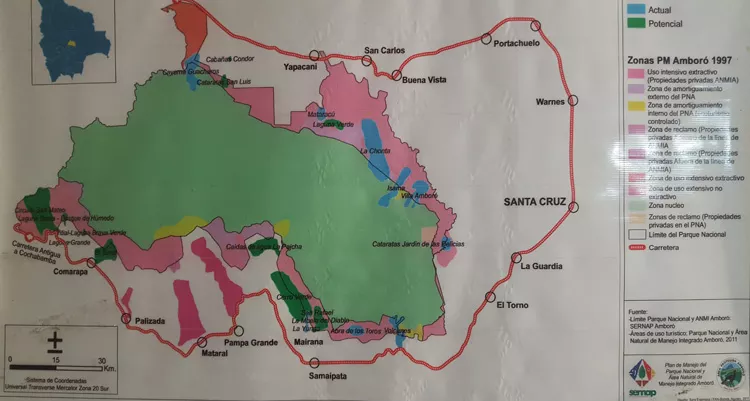
Mataracu - Map
Photos Amboro N. Park North Side-Mataracu
mataracu.
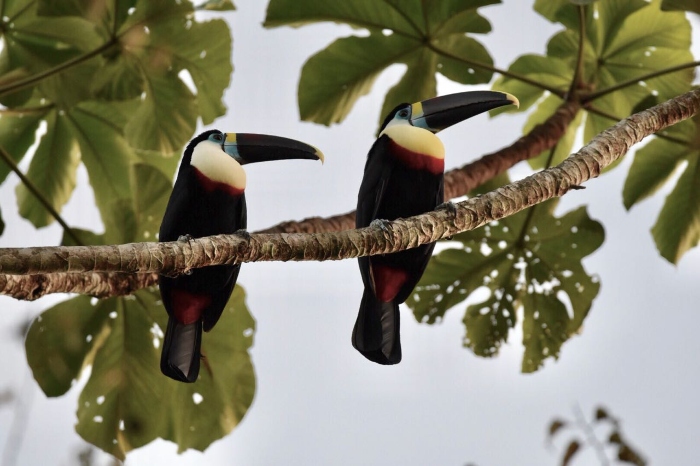
La Chonta
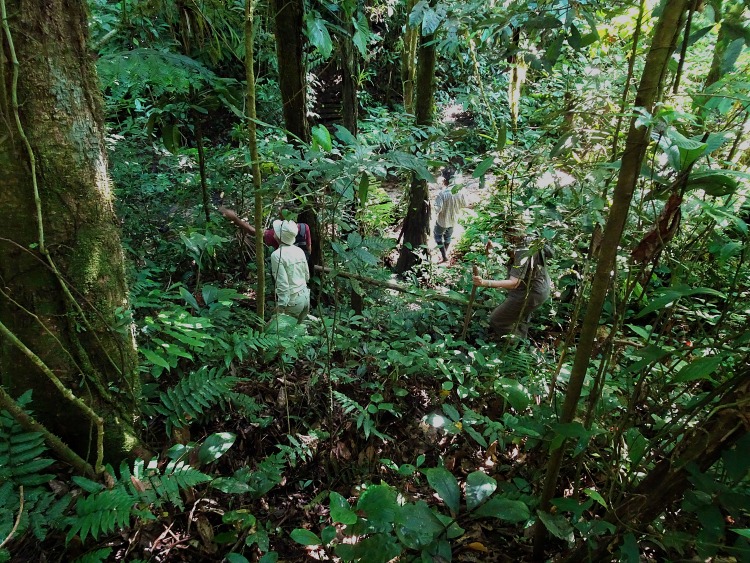
Saguayo
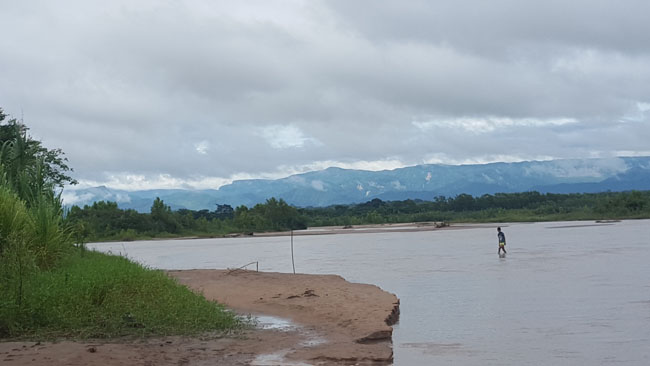
Reviews - Commentaries Viajes al Amboro
Home > Parque Nacional Amboro > Parque Amboro Zona Norte
© All rights reserved / Copyright © 2018 Amboro Tours - Terms and Conditions - Realization Ambory V.

Amboro National Park
Quick navigation.
Amboro National Park is located near the midway point of Bolivia and is a neighboring protected area of Carrasco National Park. The park covers an area of 1,709 square miles (4,425 sq km).
The park is located along the Andes mountains' eastern side at the junction where their mountains make a more abrupt northwestward turn. This region is affectionately known as the “Elbow of the Andes.”
The park is part of a larger bioregion that includes a variety of differing habitats. The varying ecosystems include Bolivian montane forest, Chiquitano dry forest, Dru Chaco, Southwest Amazon moist forest, and Yungas.
The vegetation, of course, varies with the elevation changes, which extend from 980 feet (300 m) up to 10,951 feet (3,338 m). The park's majority is situated at elevations over 3,300 feet (1,000 m) and below 6,600 feet (2,000 m).
The elevation and varied ecosystems make the national park one of the most diverse in the world. There are over 3,000 identified and recorded species of plants. The bigleaf mahogany, mountain pine, and the giant tree fern are some of the more intriguing species.
As would be expected with the ecosystem and habitat variations, there is a diversity of wildlife. With over 900 species of birds, the national park accounts for over 60% of the bird species located in the country. This makes the park a birdwatcher’s coveted destination.
The giant anteater, jaguar, ocelot, cougar, caiman, and spectacled bear are some of the most hopeful wildlife sightings. Although the park features 177 species of mammals, it is a reptilian and amphibian haven. There are at least 173 species of amphibians and another 135 species of reptiles.
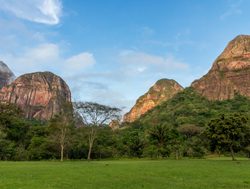
The park's highlight is easily the diversity of wilderness that is available for an escape into the wilds of nature. With mammals, amphibians, and reptiles each having over 130 species with an additional 900 species of birds, there is something for everyone.
Another highlight for those who embark on exploring Amboro is the true Indiana Jones-type experience. Waterfalls, rainforest, mountains, and more all wait for the explorer who is ready to walk on the wilds of this magnificent and diverse collection of ecosystems.
Amboro National Park Trails
There are several trails scattered throughout the amazing landscape of Amboro. Hiking on the trails and through the forests and stunning landscapes is one of the national parks' most popular activities.
Orquideas Trail
This is a short trail that only takes about an hour. It is fairly easy and quite rewarding with beautiful orchids and bromeliads escorting your journey past a beautiful waterfall.
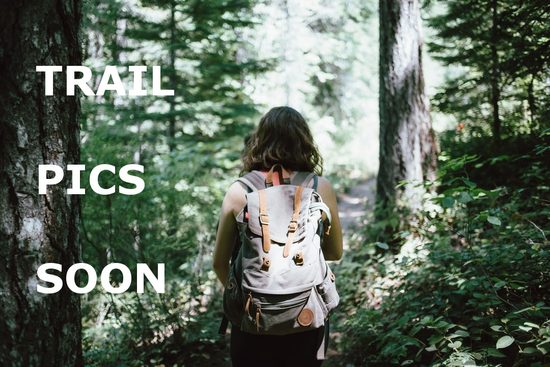
This trek up is rated moderate and takes about three hours. This is a popular trail for those who enjoy birdwatching while reaching the top, which offers a striking panoramic view.
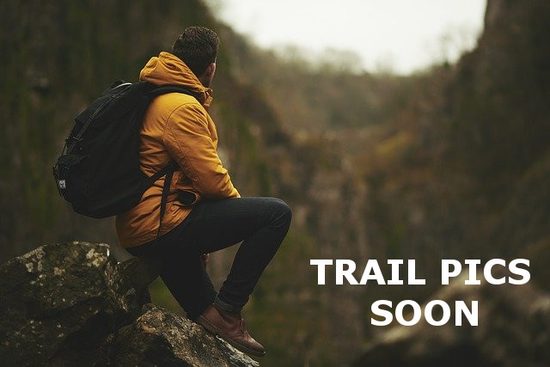
Condor Trail
This hike rewards trekkers with a striking view of Refugio Los Volcanes along with views of the surrounding picturesque landscapes. Orchids and other flowering vegetation is one of the highlights of this trail which takes about 2.5 hours to complete.
Parque and Condor Trail
This is a more challenging trail and requires hikers to be in good condition. It combines parts of the Condor Trail into the Parque Trail. It will take about 4 hours to complete. The trail traverses across the Elvira River multiple times while passing by views of giant ferns, large bibosi trees, abundant orchids, and other flowering vegetation. The remarkable panoramic views are another highlight of this hike.

Park Protection
Amboro National Park was created to protect one of the more diverse ecosystems in the world. Located on the Andes' eastern side, the varied habitats serve as a refuge for an equally diverse collection of wildlife.
The global community must do all that we can to protect the habitats and ecosystems that allow vulnerable wildlife to survive. Deforestation and the encroachment of humankind are the largest threats to the area and the wildlife that calls it home.
It also protects one of the greatest concentrations of birds per square mile (per sq km) in the world. It is a bird lover’s haven.
Amboro Highlights
- Pristine and diverse wilderness
- Tropical paradise
- 130+ species of mammals, amphibians, and reptiles
- Between 800 and 900 species of birds
- Bolivian Life, A Guide to Amboro National Park, https://www.bolivianlife.com/amboro-national-park/ , retrieved October 2020.
- Frommers, Amboro National park, https://www.frommers.com/destinations/santa-cruz-de-la-sierra/attractions/amboro-national-park , retrieved October 2020.
- LAC Geo, Amboro National Park (Bolivia), https://lacgeo.com/amboro-national-park-bolivia , retrieved October 2020.
- Lonely Planet, Amboro National Park, https://www.lonelyplanet.com/bolivia/santa-cruz-gran-chiquitania/activities/amboro-national-park/a/pa-act/v-107299P1/1319426 , retrieved October 2020.
- Ruta Verde, Amboro National Park (North Side), https://www.rutaverdebolivia.com/tour/amboro-national-park/ , retrieved October 2020.
- Wikipedia, Amboro National Park, https://en.wikipedia.org/wiki/Amboró_National_Park , retrieved October 2020.
+51 950 738 710
+51 971 536 330
(+51) 084 774682

MADIDI PAMPAS TOUR 5D – JUNGLE BOLIVIAN
Description..
This is our 5-day pampas and madidi combo tour. We will visit the fascinating Madidi National Park where you can learn how wonderful the Bolivian jungle is, accompanied by many species of flora and fauna where you will be in direct contact with nature and thus be able to enjoy your stay in Madidi.
GENERAL DESCRIPTION
Bolivia is a country of multiple ecosystems. Its geography encompasses lakes and lagoons, rivers, mountains, valleys, plains and Amazonian forests. Likewise, Pampas Madidi Tour, a highly recommended tourist destination for those who love nature and ecotourism, in this 5-day adventure you can be in direct contact with the environment and enjoy these places to the fullest.
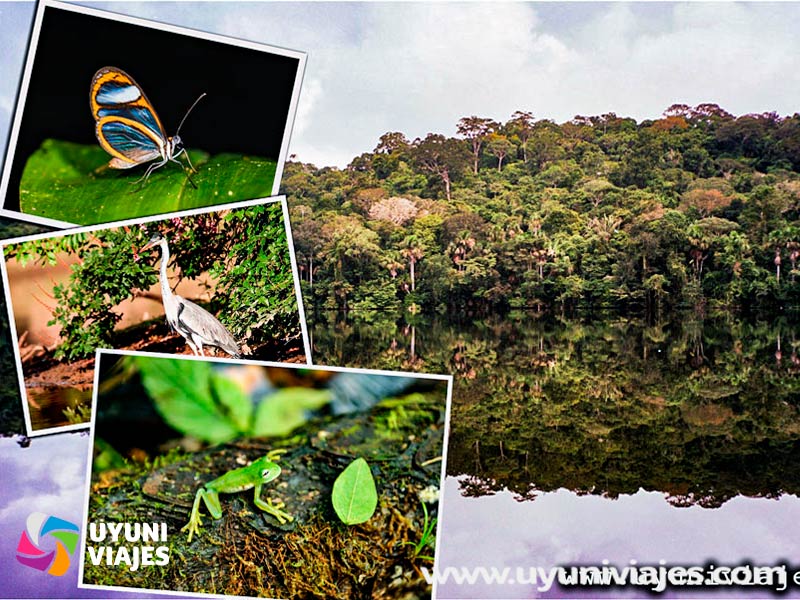
Itinerary
recommendations, important data, day 1. river beni – madidi national park..
We start the morning very early to then transport us in a boat down the Beni River, later we will enter the Madidi National Park , which is one of the parks with the greatest biodiversity in the world. Next, after about 3 hours of travel along the Beni and Tuichi rivers, we will arrive at our Lodge to later enjoy a delicious lunch and then rest in the hammocks under the trees. In the afternoon we will take a walk through the jungle to learn about the medicinal use of some thousands of species of plants and the observation of wild animals, such as: monkeys, deer, mountain pigs, capybaras and numerous birds. Finally, after dinner, we will go on a night walk to feel the sounds of the jungle and observe nocturnal animals.
DAY 2. CAQUIAWARA – TAUCHI RIVER.
After a nutritious breakfast in the morning, we will take a short boat ride to Caquiawara, a clay outcrop where parrots and macaws nest and feed. Next, we will go through an interpretation trail and then we will locate ourselves at the viewpoint for a comfortable bird watching. We will return for a delicious lunch at the lodge. Finally, in the afternoon we will do sport fishing in the Tuichi River. Therefore, at sunset we will go swimming and cool off in the Tuichi River.
DAY 3. RURRENABAQUE – SANTA ROSA DEL YACUMA.
We start the day with a good breakfast, the boat will take us back to Rurrenabaque, where we will arrive around 08:30. Likewise, we will have a short rest before the transfer in comfortable cars from Rurrenabaque to Santa Rosa del Yacuma . After about 3 hours, we arrive at our Lodge, next to the Yacuma River, where a delicious lunch will be waiting for us and we will have free time to rest in the hammocks. In the afternoon we will take a boat ride to observe the wildlife: caimans, anacondas, turtles, capybaras, pink dolphins, different species of monkeys and innumerable species of birds.
DAY 4. PAMPA.
In the morning, after a good nutritious breakfast, we will start the walk through the pampas to look for anacondas and lizards. Then, after a nutritious lunch, we will have a short break at the lodge. Finally, we will be able to swim with the dolphins. Therefore, after dinner, we will take a boat ride to shine a flashlight on the eyes of the lizards.
DAY 5. RURRENABAQUE.
Our last day in Pampas de Madidi we will have a good breakfast and then navigate the Yacuma River, we will do sport fishing. After lunch, we return by Jeep to Rurrenabaque, where we arrive at approximately 5:00 p.m.
THAT INCLUDED THE MADIDI PAMPAS TOUR.
- Transportation in jeep and motorboats
- Pick up from the airport and / or from the accommodation
- Guide – English and Spanish speaking
- Meals (vegetarian options available upon request)
- 1 night of camping (equipment included)
- Accommodation in private bedrooms or cabins (single, double or triple) with private bathroom in Pampas, shared bathroom in Madidi – mosquito nets, beds, sheets / covers
- Drop off at the airport if you have a late flight the day the tour ends
THAT NOT INCLUDED THE MADIDI PAMPAS TOUR.
- Entrance fees to the Madidi National Park – 200 Bs. and to the Santa Rosa Protected Park – 150 Bs.
- Travel insurance – recommended
- Additional beverages
- Breakfast the first day, dinner the last day
- Sunglasses and sunscreen
- Insect repellent
- Any items not mentioned above
RECOMMENDATIONS
- Personal water bottle
- Comfortable shoes for walks (Trekking)
- Extra change of clothes
- Small backpack
- Wide brim hat
- Flashlight (optional)
MORE TOURS HERE.
WE ALSO OFFER RURRENABAQUE 3 DAYS.

Related Products
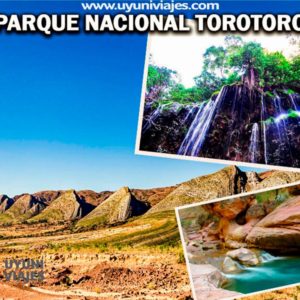
TOROTORO NATIONAL PARK TOUR 4D/3N
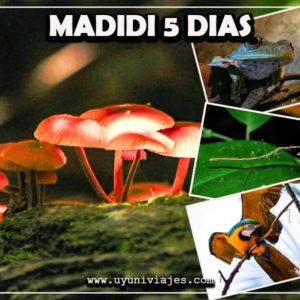
MADIDI NATIONAL PARK 5D - BOLIVIAN JUNGLE
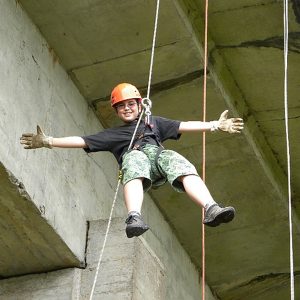
RAPPELLING IN LA PAZ

IMAGES
COMMENTS
DAY 2: REFUGIO LOS VOLCANES. 07:00 AM Breakfast. 08:00 AM Depart for the trek into the Amboro National Park, this trek can take up to 7 hours and we trek through a range of rivers and the views are incredible, we will visit a few waterfalls along the way, check and set up the camera traps in the area and observe areas for birds and wildlife.
Amboro Tours is a legally Bolivian Company. We are located at Buena Vista, Santa Cruz , Bolivia South America We have being working since the year 1999 without interruptions and directly operating touristic destinations, servicing and supporting Receptive Tourism based on the field experiences of our leaders with updates continuously transmitted to the staff.
The north side of Amboro National Park is an ecological masterpiece located approximately 150 km north west of the city of Santa Cruz. ... The tour starts in Santa Cruz at 6.00 am in the morning, when a vehicle will bring you to Buena Vista town. ... 'My wife Uschi Janssen and I thoroughly enjoyed our visit to Parque Amboro (2-4 September 2010
Amboro Tours Bolivia. We are a Tour Operator and travel agency located in BuenaVista,Ichilo-Santa Cruz- Bolivia. We have being working since 1999 without interruptions and directly operating touristic destinations and supporting Receptive Tourism based on the field experiences of our leaders with continuously updates transmitted to the staff.
El parque nacional Amboró es una obra maestra ecológica de cerca de medio millón de hectáreas, a aproximadamente a 150 km al NO de la ciudad de Santa Cruz. ... El tour a Amboró empieza en Santa Cruz a las 6:30 a.m. cuando un vehículo te llevará al pueblo de Buena Vista. Allí estará nuestro guía esperando para recibirte y trasladarte ...
Gracias Marcos - Amboro Tours. Read more. Written January 29, 2016. This response is the subjective opinion of the management representative and not of Tripadvisor LLC. Der D. 55 contributions. 4. Amboro tours. We did as jungle tour to Amboro park with Amboro tours. ... El parque Amboro es en santa cruz Bolivia. Para contratar un tour tendria ...
Southern Amboró National Park (Refugio Los Volcanes) - 2 Days. Home to lush rainforests and an astonishing diversity of wildlife, Parque Nacional Amboro has long been a coveted destination in the protection of natural heritage in Bolivia. Experience this gorgeous region on a fun-filled adventure with plenty of hiking trails, pristine ...
This program / itinerary is a brief explanation of the activities of 1,2,3 days in Amboro National park Noth side. 1st day .-. These tours to Amboro National park north side commence usually at 8H00 by land on a car. The first part of this trips takes about 2 Hours (100 Km) to a village near the park.
Visit Amboro National Park on a 2-day, all-inclusive private tour that features an overnight at a solar-powered lodge in the rainforest. A personalized itinerary and private guide mean you'll experience Amboro National Park highlights at your own pace: hike through the jungle, go birdwatching, search for nocturnal wildlife, and make the scenic trip from Santa Cruz in the comfort of a private ...
Explore Amboro National Park with a private guide on an overnight trip from Santa Cruz that's tailored to you. Hike and swim in the jungle, search for wildlife, and go bird-watching, spending the night at the Refugio Los Volcanes, a solar-powered lodge surrounded by tropical forest. With transport from Santa Cruz, park entrance fees, meals ...
08:00 AM Depart for the trek into the Amboro National Park, this trek can take up to 7 hours and we trek through a range of rivers and the views are incredible, we will visit a few waterfalls along the way, check and set up the camera traps in the area and observe areas for birds and wildlife. Lunch will either be at the lodge or a picnic at a ...
By law tourists may only enter Amboró National Park with a certified guide. There are plenty of tour operators serving the national park offering different programs for varying lengths of time. The average cost for a good quality 2 day / 1 night tour is around $120 US per person which typically includes the following: Experienced local guide
The lodge Refugio Los Volcanes is located close to the southern part of Amboró National Park and is roughly a 2-hour drive from the city of Santa Cruz de la Sierra. Tucked away in a deep valley surrounded by the Volcanes mountain range, this place has a privileged location with spectacular views of sandstone rock cliffs and the subtropical ...
Plan B: Amboró National Park Day Tour from Samaipata Tour Overview. Tour Cost: 180 Bolivianos per person Duration: 6-8 hours, depending on hiking speed Hike Distance: 8-9 miles (12-15 kilometers) What to Bring: Comfortable shoes (they may get muddy and wet), sunscreen, bug repellent, rain jacket, lunch and snacks, water, camera The Excursion. We left Santa Cruz de la Sierra and found ...
Amboró National Park, also known as the "TCNL Germán Busch" Natural Reserve and in Spanish as the "Parque Nacional y Área Natural de Manejo Integrado Amboró", had its beginnings on December 20, 1973, when it was established under Supreme Decree No. 11254. At that time, it was granted the category of Natural Reserve and bore the name "TCNL ...
It is easy to access Amboró through two roads that connect the cities of Cochabamba and Santa Cruz. Three hours west of Santa Cruz by car, the park can be reached using either the old south road or the new north road. It depends on which side of the park you want to access. On the north of Amboró there are 50-meter-high waterfalls cascading ...
The Amboró National Park and Integrated Management Natural Area is a protected area of Bolivia and one of the world's most biodiverse reserves, located west of the department of Santa Cruz, in the so-called "Elbow of the Andes", where the western mountain range changes course in a southerly direction. Its western margin borders with the Carrasco National Park, located in the department of ...
From Samaipata from Santa Cruz or visa versa, the route is an easy one. Collectivos run all day between the terminal on the corner of Av. Omar Chavez Ortiz/Soliz de Olguin in Santa Cruz and the central plaza in Samaipata Bolivia. Depending on the season the cost is $30-40B's per person. The journey will take around 4 hours and the road.
Los tours en Parque Nacional Amboró suelen incluir guías expertos que te acompañarán durante el viaje, brindándote información y conocimientos sobre Parque Nacional Amboró. Esto te permitirá aprovechar al máximo tu experiencia, sin tener que preocuparte por la planificación y organización.
Amboró National Park in central Bolivia is a nature reserve with over 912 species of birds, over 177 mammalian species including puma, ocelot, and the rare spectacled bear. Covering an area of 4,425 km² (1,709 sq mi), it is protected from human settlements, hunting, mining and deforestation , though problems with all these still exist within ...
Un Breve Programa para actividades eco-turisticas en visitas guiadas en el Parque Nacional Amboró Zona Norte. Este programa/itinerario es una explicacion de las actividades de 1,2 o 3 días en los tours al Parque Nacional Amboró. 1er día. - Estos Tours al Parque Amboró comienzan generalmente a 8H00 en la ciudad de Santa Cruz.
Amboro National Park. Amboro National Park is located near the midway point of Bolivia and is a neighboring protected area of Carrasco National Park. The park covers an area of 1,709 square miles (4,425 sq km). The park is located along the Andes mountains' eastern side at the junction where their mountains make a more abrupt northwestward turn.
Its geography encompasses lakes and lagoons, rivers, mountains, valleys, plains and Amazonian forests. Likewise, Pampas Madidi Tour, a highly recommended tourist destination for those who love nature and ecotourism, in this 5-day adventure you can be in direct contact with the environment and enjoy these places to the fullest. DAY 1.